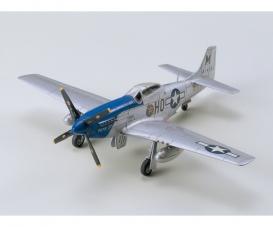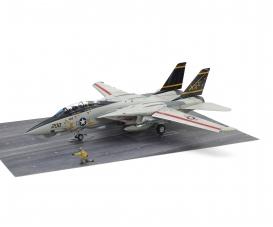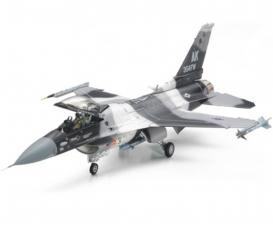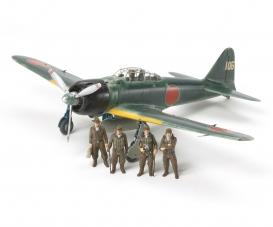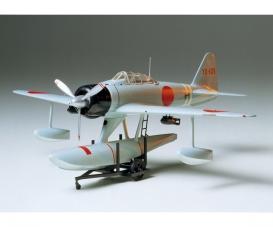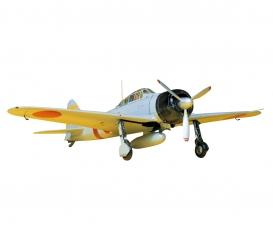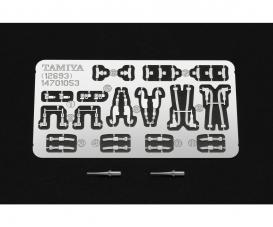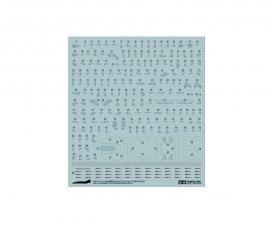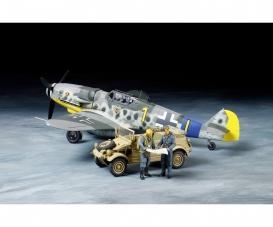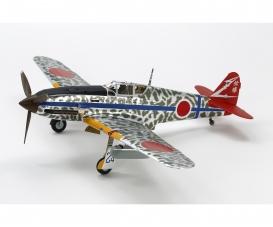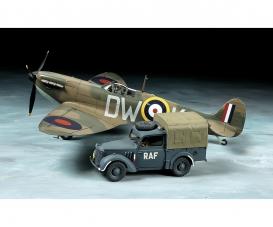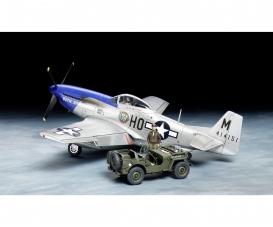Model aeroplanes
Conquer the skies with our detailed model aeroplanes! From legendary fighter planes to modern jets: these models bring the fascination of aviation directly to your home. Find out more about our model aeroplanes here.
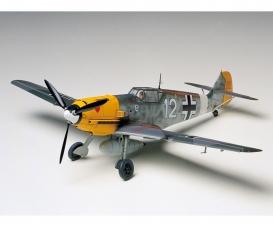
Model aircraft kits 1:48
1:48 Ger. Messerschmitt BF109E-4/7 Trop
300061063€28.99
Article number: 300061063 Artikelbezeichnung: 1:48 Ger. Messerschmitt BF109E-4/7 Trop The Messerschmitt Bf 109E was the Luftwaffe's mainstay fighter in the early stages of WWII. This kit depicts the E-4, which was produced from May 1940 and saw extensive action during the Battle of Britain, and the E-7, which was fitted with a drop tank for increased range. The angular form of the aircraft has been accurately reproduced complete with details such as a canopy that may be assembled in open or closed position, a rack for the E-7's drop tank, and the Trop version's air intake with sand filter. One pilot figure and three marking options are included. Warning! Not suitable for children under 14 years.
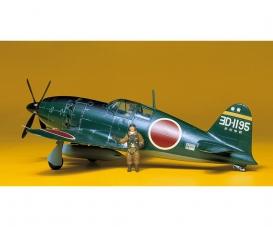
Model aircraft kits 1:48
1:48 Jap. Mitsu. J2M3 Interceptor Raiden
300061018€16.99
Article number: 300061018 Product: 1:48 Jap. Mitsu. J2M3 Interceptor Raiden The J2M Raiden (Allied reporting name "Jack") was developed by the Japanese Navy in WWII as a land-based interceptor. It began to reach units from September 1944 and they were used to intercept B-29 bombers which were attacking Japan. This kit accurately depicts the J2M3 variant and allows modellers to assemble either deployed or retracted landing gear. Parts for a drop tank and two pilot figures, as well as three marking options, including a 302nd Kokutai aircraft, are included. Raiden (Jack) Warning! Not suitable for children under 14 years.
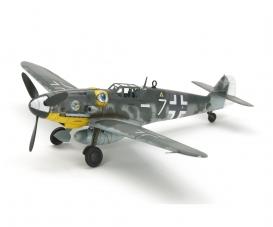
Model aircraft kits 1:72
1/72 Bf-109 G-6 Messerschmitt
300060790€26.99
Article number: 300060790 Product: 1/72 Bf-109 G-6 Messerschmitt In great news for modelers in the compact 1/72 scale, the "Gustav" is to be released as a Tamiya kit! With over 30,000 produced, the Messerschmitt Bf109 is the most prolifically manufactured fighter in history; of its variants, the G-6 was the most numerous at 13,000 aircraft. In response to improving Allied foes in the air, Bf109 G aircraft had the more powerful DB605 engine, and from the G-6 were equipped with dual 13mm MG131 machine guns that required the distinctive bulges on either side of the cockpit cowling known as "Beule." Some were even given a 20mm cannon gondola under each wing for further improved firepower. The Bf109 G-6 was deployed on both the Western and Eastern fronts, in particular dominating Soviet adversaries as it continued in service through to the end of WWII. About the Model - This is a 1/72 scale plastic model assembly kit. - The striking, refined form of the G-6 variant Bf109 is captured, including depictions of the Beule bulges. - This product takes inspiration from the highly accurate 1/48 model (Item 61117). Please note that engine cowlings are depicted closed. - The cockpit is inserted after left and right fuselage halves have been put together. It has an accurate interior with streamlined assembly. - Canopy can be assembled in open or closed state. - Landing gear struts have a solid attachment point for accurate attachment angle and position. - Comes with optional drop tank parts. - 2 marking options are planned - JG51 (with distinctive eye marking on the Beule) and JG54. Detailed Plastic Kit
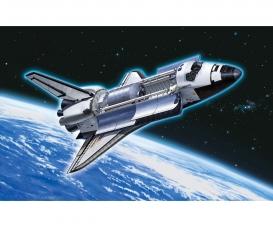
Model aircraft kits 1:72
1:100 Space Shuttle Atlantis
300060402€66.99
Article number: 300060402 Product: 1/100 Space Shuttle Atlantis NASA's space shuttle was first launched on April 12, 1981 and the fleet has accomplished numerous historic missions throughout their 30 years of service. The spacecraft conducted the latest research and played an important role in building the largest structure in space thus far, the International Space Station. The final space shuttle mission ended on July 21, 2011 with the flight of the Atlantis and the shuttle fleet is now destined for public display in museums across the United States. Warning! Not suitable for children under 14 years.

Model aircraft kits 1:72
Kawanishi Shiden Type 11
300060768€14.79
Article number: 300060768 Product: 1/72 Kawanashi Shiden Type 11 Evolving from the Kawanishi N1K1 "Kyofu" floatplane, the Imperial Japanese Navy's N1K1-J Shiden had a unique pedigree amoung WW2 landplane fighters of the world. In January 1942, the Kawanishi Aircraft firm began adaptation of the Kyofu into a land based fighter, strictly as a private venture. This project was soon officially authorized under the designation N1K1-J, with the first prototype flying in December 1942. The airframe was basically the same as its predecessor, with main landing gear and tall wheel replacing the floats. In place of Kyofu's Mitsubihi Kasei engine, a more compact and powerful Nakajima Homare engine was installed. Excellent performance and superb maneuverability was achieved using this engine, however it brought about serious problems. In order to use all of the available power in the engine, a large diameter propeller was required. This required unusually long main landing gear legs, because of the midwing configuration. This caused difficulties in the landing gear retraction system. Kawansihi engineers managed to solve the problem by introducing telescopic main landing gear legs. The complex gear system and unreliability of the engine, plagued the N1K1-J throughout its career, until the introduction of the improved, low-wing N1K2-J Shiden-Kai. About 1,000 N1K1-J fighters were produced and were active around the Phillipine islands, Formosa, Okinawa and over the Japanese Island of Honshu. Detailed Plastic Kit of model Kawanashi Shiden Type 11 in scale 1:72 Warning! Not suitable for children under 14 years.
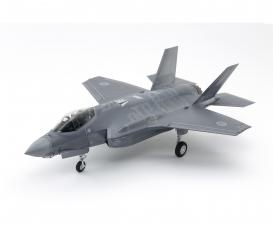
Model aircraft kits 1:48
1/48 F-35A Lightning II
300061124€97.99
Article number: 300061124 Product: 1/48 F-35A Lightning II Here is an outstanding entrance into the legendary 1/48 Aircraft Series: this time, the A variant of the Lockheed Martin F-35 Lightning II. The F-35 - variant A for the Air Force, B for the Marines and C for the Navy – was developed under the Joint Strike Fighter Program (JSF), and is seen as one of the fifth generation fighters. These aircraft possess highly advanced stealth characteristics and network connectivity, plus superior situational awareness provided by numerous integrated sensors. The F-35 Lightning II was first delivered in 2015, and deployment of over 3,000 F-35s is planned around the world. Inheriting the Lightning appellation from the famed P-38, the F-35 will lead worldwide air arms for many years to come. Warning! Not suitable for children under 14 years.
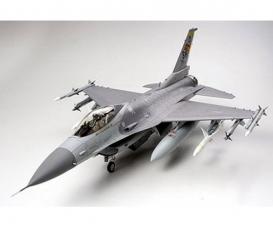
Model aircraft kits 1:32
1:32 Lockheed Mar.F-16CJ Fighting Falcon
300060315€164.99
Article number: 300060315 Product: 1:32 Lockheed Mar.F-16CJ Fighting Falcon This is the first ever 1/32 scale F-16 model to replicate the characteristic large air intake duct, nicknamed "Big Mouth". The F110-GE-129 jet engine is also replicated in precise detail, and can slide into place on a hook and rail system exactly like the actual aircraft. The entire engine can also be displayed outside the aircraft using the included cart. This model achieves a level of accuracy only possible in such a large-scale work. The upper surfaces of the wings are molded to the main body of the plane in one single piece, creating a "Blended Body" which artfully depicts the F-16's beautiful, streamlined form and proportions. The model features screw-mounted main body and die-cast landing gears with actual rubber tires for extra durability. This model makes use of the newly developed mini poly caps to ensure that missiles, ECM pod and external fuel tanks are removable and interchangeable even after assembly. This way, modelers can enjoy depicting different weapon configurations specific to various F-16 missions. Use of poly caps also enables trailing edge flaps, horizontal stabilizer fins and vertical tail fin flaps to move freely after assembly. Scope of delivery: Kit, instructions, decor Warning! Not suitable for children under 14 years.
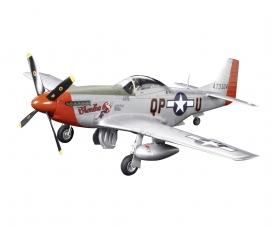
Model aircraft kits 1:32
1:32 North American P-51D Mustang
300060322€134.99
Article number: 300060322 Product: 1:32 North American P-51D Mustang The P-51 Mustang is considered by many to be the best fighter aircraft of WWII. The P-51 Mustang came about when the British Purchasing Commission asked North American Aviation to produce the Curtiss P-40 for the RAF, but North American stated they could build something better. The P-51D is considered by many experts to be the definitive variant of the Mustang as it was the most widely produced. It featured a bubble canopy which gave the pilot superb all-round visibility as well as a heavier armament of six 12.7mm machine guns. Wing racks allowed the carriage of drop tanks to extend range or bombs for ground attack. P-51Ds were instrumental in helping the Allies gain air superiority over Europe, and after Germany's defeat, they continued their role as long-range escorts for B-29s attacking Japan. Many also saw service during the Korean War as fighter-bombers and a few even continued to serve with air forces of less developed nations until the 1980s. Scope of delivery: Kit, instructions, decor Warning! Not suitable for children under 14 years.
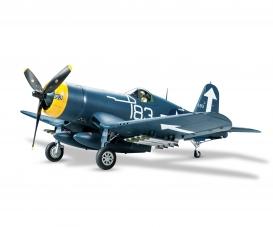
Model aircraft kits 1:32
1:32 US Vought F4U-1D Corsair
300060327€165.00
Article number: 300060327 Product: 1:32 US Vought F4U-1D Corsair This is the D variant of the popular Corsair World War II fighter plane. It uses new parts to recreate features specific to the F4U-1D, which was the first Corsair to be cleared for use on aircraft carriers. This fighter-bomber could carry drop tanks on new hard points under the wing root, and up to 8 rockets under the outer wing. It provided invaluable close support for ground troops during landings in places such as the Philippines and Okinawa, and continued to serve after WWII, in Korea. F4U-1D Specific Detail differences from previous variants: 1. The semi-bubble canopy was altered during production to remove upper side frames and improve visibility. 2. Propeller blades were thicker from the root. 3. Hardpoints under the wing root allowed carrying of bombs and drop tanks. 4. The tail wheel cover had a new fairing to improve aerodynamics. 5. Outer wing sections had extended metal areas with mounts for eight rockets total. 6. Cockpit floor window was scrapped. Warning! Not suitable for children under 14 years.
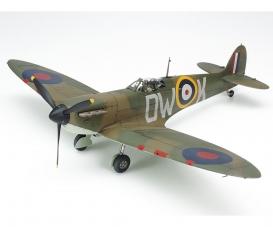
Model aircraft kits 1:48
1:48 Brit. Supermarine Spitfire Mk.I
300061119€43.99
Article number: 300061119 Product: 1:48 Brit. Supermarine Spitfire Mk.I The Supermarine Spitfire needs little introduction, one of the best-known aircraft deployed by the Royal Air Force in the Battle of Britain, as British and German forces struggled for control of the skies over the English Channel. The Mk.I had a streamlined form with elliptical wings designed for speed, and was powered by a Merlin engine. This legendary bird has received a complete makeover from Tamiya’s designers with new tooling for an updated and more accurate appearance in the 1/48 Aircraft Series! • 1/48 scale plastic model assembly kit. • Can be assembled to recreate many of the extensive Spitfire Mk.I variants. • Points of interest include superb detailing in areas such as the cockpit and panel lines. • Separate parts are used to recreate main landing gear and horizontal stabilizers. • Comes with 1 figure depicting a seated pilot. • Photo-etched parts are included to recreate radiator, oil cooler, gun sight, seatbelt components and more! • 3 marking options.
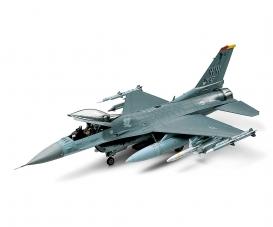
Model aircraft kits 1:48
1:48 F-16CJ Fighting Falcon Lockheed Mar
300061098€62.99
Article number: 300061098 Product: 1/48 Lockheed Mar.F-16CJ Fighting Falcon About the F-16CJ The F-16 is one of the world's top lightweight multi-role fighter aircraft. Since first deployment to U.S. Air Force (USAF) units in the late 1970's, total production numbers have exceeded 4,000, making it the second most highly produced jet fighter plane following the F-4 Phantom. The latest F-16 variant deployed to USAF units, the F-16C Block 50, is capable of precision night and all-weather bombing, and features advanced digital electronics for radar and cockpit displays. The slight variant, the F-16CJ (Block 50), is fitted with HARM Targeting System (HTS) and is used specifically for SEAD (Suppression of Enemy Air Defenses) missions. The F-16CJ (Block 50) has flown SEAD missions over Iraq while monitoring the northern and southern no-fly zones and during Operation Iraqi Freedom. About the Model - Model represents the F-16CJ (Block 50) as used for USAF SEAD missions. - Sleek fuselage including aerodynamic blended wing body design accurately reproduced. - Accurately curved bubble top canopy can be assembled in the opened or closed position. - Horizontal stabilizers are movable and flaperons can be modeled in both the up or down positions. - A range of weapons and accessories are included such as HARM, AMRAAM, and Sidewinder missiles (M & X variants), detachable external fuel tanks, ECM pod, and HTS pod. - One pilot figure included and can be depicted with either standard or JHMCS flight helmet. - Detailed markings for 3 aircraft, including the 5th Air Force commander's aircraft stationed at Misawa airbase in 2005, are included.
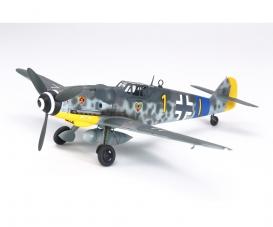
Model aircraft kits 1:48
1:48 Ger. Bf109 G-6 Messerschmitt
300061117€49.99
Article number: 300061117 Product: 1:48 Ger. Bf109 G-6 Messerschmitt This precision model aircraft assembly kit depicts the Messerschmitt Bf 109 G-6 variant. It compliments Tamiya’s other variants such as the E-3 and E-4/7 Trop. The Bf 109 is a legendary name in aviation, an aircraft which combined longevity and versatility in the hands of the Luftwaffe and other air forces. The G-6 was the most prolifically produced Bf 109, accounting for more than a third of the total. Introduced in early 1943, it could be fitted with underwing 20mm cannons in pods, or synchronized 13mm machine guns in distinctive bulges ahead of the cockpit, and was powered by the Daimler-Benz DB605A liquid-cooled V12, which gave a top airspeed of 640km/h.
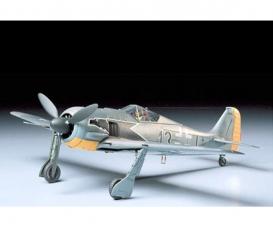
Model aircraft kits 1:48
1:48 Ger. Focke Wulf Fw190 A-3
300061037€28.99
Article number: 300061037 Product: 1:48 Ger. Focke Wulf Fw190 A-3 The Focke-Wulf Fw 190 served alongside the Messerschmitt Bf 109 to defend Germany from the mid stages of WWII to the end of the war. This kit reproduces the A-3 variant of the Fw 190, which outclassed the RAF's Spitfire Mk.V when it entered service. The aircraft's characteristic radial engine features fine cooling fin and exhaust details. Three marking options, including an aircraft flown by German ace Hans Hahn, are included. Warning! Not suitable for children under 14 years.
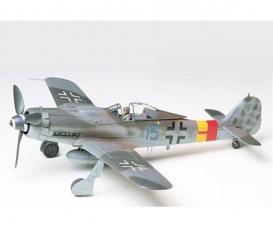
Model aircraft kits 1:48
1:48 Ger. Focke Wulf Fw190 D-9
300061041€28.99
Article number: 300061041 Product: 1:48 Ger. Focke Wulf Fw190 D-9 Following the successful entry of the Focke-Wulf Fw190A series of fighter aircraft over the English channel during the autumn of 1941, the German RLM requested high altitude version to complement the fighter fleet, and three projects were started. The Fw 190B used the B.M.W. 801 turbosupercharged radial engine and a pressurized cockpit, but very few of these were built. The Fw190C was powered by a 1,750hp Daimler Benz DB603A in-line engine, of which three prototypes were built. The third high altitude project was based on the Focke Wulf Fw190A airframe and powered by a Junkers engine. The fuselage was lengthened to accommodate the V-12 cylinder, liquid cooled, 1,750hp Jumo 213 engine, and made its initial flight during the winter of 1941 - 42. Five further prototypes were produced, plus small batch of Fw 190 D-Os were completed from standard production Fw 190A-7 airframes. These pre-production aircraft were followed by the Fw190 D-2 through D-8 designations. The Fw 190D-9 began production in June 1944, with early versions having the flat topped canopy, and from W. Nr. 210002 onwards having the Galland hood (blown canopy). It went into combat with the III/JG 54 "Grunherz" (Green Hearts) in September 1944, at Achmer, Germany, as top cover for the new Messerschmitt Me262 Jet fighters then entering service.

Model aircraft kits 1:48
1:48 Ger. Heinkel He162A-2 Salamander
300061097€40.99
Article number: 300061097 Product: 1/48 WWII Dt.Heinkel He162A-2 Salamander The Luftwaffe's Last Hope As the situation became more desperate for the German forces near the end of WWII, a call was made for a new inexpensive jet fighter that would be simple to produce and fly. In the amazingly short span of 3 months from drawing board to first flight of the prototype, Heinkel produced the small, sporty-looking He162. The lightweight fighter featured mainly wooden construction and was powered by a BMW003 turbojet, which made it the fastest jet fighter of WWII with its 838km/h top speed. Reaching combat units in late March 1945, the little fighter managed to record some combat successes despite the acute fuel and parts shortage. About the Model High-quality assembly kit display model of the He162 A-2 "Salamander" jet fighter. ★Length: 205mm, Width: 149mm ★Top-mounted BMW003 turbojet engine with parts for opened and closed engine bay covers to allow full display of internal details. ★Special dolly included to display the engine separate from the aircraft. ★Canopy can be posed in the open or closed positions, and the ejector seat is removeable. ★Includes 1 pilot figure and 4 types of markings. Warning! Not suitable for children under 14 years.

Model aircraft kits 1:48
1:48 Ger. Messerschmitt Bf109 E3
300061050€28.99
Article number: 300061050 Product: 1:48 Ger. Messerschmitt Bf109 E3 About the Messerschmitt Bf109 E-3 Without a doubt, the Messerschmitt Bf109 can be claimed as the most famous and successful German aircraft from the WW2. It was the world's most advanced fighter at the time of its debut in 1936, and remained as the standard fighter for the Luftwaffe throughout the conflict. Created by the brilliant designer Willi Messerschmitt, it had the smallest possible airframe built around the most powerful engine available. It also boasted many of the then innovative features such as an all metal stressed skin construction, retractable main landing gear, automatic Handley-Page leading edge slats, etc. The Bf109 saw first combat during the Spanish Civil War and fully demonstrated its exceptional maneuverability, inherited from its precedent Bf108 Taifun (Typhoon) multi-purpose sports plane. The Bf109 underwent numerous improvement throughout its career, and mass production of the E variant started late in 1939. Within one year, about 2,000 "E" aircraft were rolled out. Its excellent performance greatly contributed in the active service of German pilots at the Western Front and during the "Battle of Britain". The E-3 version used an improved Daimler-Benz DB601Aa engine capable of 1,100 h.p. output. This engine had provision for mounting a 20mm MG FF cannon on the crankcase and firing through the propeller hub. The Messerschmitt Bf109E was one of the best fighters of the early WW2 period, on a par with the British Spitfire. Warning! Not suitable for children under 14 years.

Model aircraft kits 1:48
1:48 Ki-46 III 100 & Kurogane (4)
300025217€43.49
Article number: 300047500 Product: 1:48 Ki-46 III 100 & Kurogane (4) Tamiya welcomes this cost-effective set which includes Item 61092 1/48 Mitsubishi Ki-46 III Type 100 Command Recon Plane (Dinah) and Item 32558 1/48 Japanese 4x4 Light Vehicle Type 95 Kurogane in a special package. During the Pacific War, the Mitsubishi Ki-46 III Type 100 was used as a strategic reconnaissance aircraft by the Japanese Army. This aircraft was powered by two 1,300 hp Ha-112-II Kinsei-Kai engines and was capable of a maximum speed of 630km/h. From the request of the Japanese army, the world's first light weight 4x4 vehicles were developed and named "Kurogane". Around 4,800 units were produced and were used for reconnaissance and communication in China, South East Asia, and the Pacific. About Item 61092 - This is a 1/48 scale plastic model assembly kit. Length: 229mm, wingspan:306mm. - The aerodynamic, streamlined form is authentically captured in style. - Six clear parts realistically depict the large canopy. - Features authentic renderings of the cockpit interior such as seats, instrument panel and transceiver. - Includes two full body figures (pilot and navigator) and four marking options. About Item 32558 - This is a 1/48 scale plastic model assembly kit. Length: 75mm. - The distinctive, roundish form is succinctly captured in style. - Choose from open or closed hood. - Metal transfer and decal recreate the star mark on the front grille. - Includes two full body figures (standing officer and driver). Assembly model kit 1/48th scale, Special Version of the Tamiya kit 61092 and 32558, new painting guide Warning! Not suitable for children under 14 years.
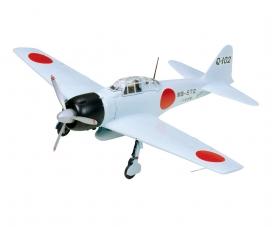
Model aircraft kits 1:48
1:48 Mitsu. A6M3 Zero Fighter T32 Hamp
300061025€16.99
Article number: 300061025 Product: 1:48 Mitsu. A6M3 Zero Fighter T32 Hamp About the A6M3 Type 32 Zero Fighter (HAMP) Much has been written over the years about the Japanese Zero Fighter Aircraft series. Much was based upon hearsay and legend and little upon fact itself. Even the Allied Forces and governments refused at first to acknowledge its existence, and when they did get a copy of it, they could hardly believe the performance it produced. The prototype zero or A6M1 first took place on paper on January 17, 1938, following the Japanese request for a shipboard fighter with a top speed of 27o kph at 12000 ft 7 6-8 hours of cruise economy endurance and 1.5-2 hours at normal combat speeds. Armament was to be two 20mm cannon and two 7.7mm machine guns plus the normal radio equipment and direction finding gear. These specifications wee so far from the existing state of the art that the famous Nakajima Company dropped out of competition, stating that they were impossible to meet. That left Mitsubishi Heavy Industries and their design team headed by Jiro Horikoshi the only company to tackle the problem. First flight was on 1 April 1939 and combat trials were concluded in July 1940 with 15 pre-production A6M2's sent to two squadrons by the end of the month. These aircraft had folding wing tips to accommodate aircraft carrier elevators, and were the ones first seen by Gen. Chennault in China, and at Pearl Harbor in December 1941. Although the A6M2 met or exceeded original design specifications, modifications were taking place at the Mitsubishi factory to improve roll rate, speed up handling aboard carriers, and utilize the uprated Sakae 21, 1,130 hp engine. The first A6M3 type 32 (code named HAMP) took to the air on 15 July 1941 with production beginning in April 42. A total of 343 aircraft were produced by August 43, when the type 52 A6M5 began production. The Type 32 Zero had the most radical change in the entire series and was readily recognized by its squared off wing tips. This reduced total span to exactly 11 meters and eliminated the cumbersome folding tips which consumed time during combat to get the aircraft down carrier elevators. The larger Sakae 21 engine gave the type 32 a better rate of climb and the shorter wing span (1 meter shorter) lessened stick forces and increased roll rate. The Hamp was utilized throughout the war, but saw most of its service off of land based installations in the southern island chains of New Guinea and the Phillipines. Warning! Not suitable for children under 14 years.
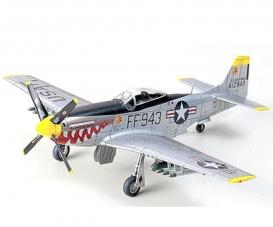
Model aircraft kits 1:72
1:72 F-51D Mustang North American
300060754€15.99
Article number: 300060754 Product: 1:72 F-51D Mustang North American Sketched out in a New York city hotel in April 1940, the North American Aviation Corporation NA73X went on to become one of the best fighters to come out of World War 2. The U.S. Army Air Corps gave it the title of P (for Pursuit) 51, and it was named Mustang by the British. Of the several variations of the Mustang, the P-51D is considered the definitive version and was the first to have the bubble canopy. More "D" models were built than any other variant, with a total of 9,603 being produced. Armed with six .50 caliber machine guns, three in each wing, with 400 rounds for each inboard gun and 270 rounds for the other four, plus underwing pylons for auxiliary fuel tans or 1000lb bombs, the Mustang was a true fighter pilots airplane. At the conclusion of WW2, Mustangs were in operation all over the world, flying in several nations air forces. When the Korean conflict broke out, hundred of F (for fighters) 51's were in Japan awaiting scraping. Because they possessed too slow speed maneuverability that was absent in the new jets then entering service, the F-51 was ideal to work with Forward Air Controllers (FAC's) on the ground in Korea. The major drawback to this was the F-51's liquid cooled engine susceptibility to anti aircraft and small arms fire when attacking ground targets. This caused the Mustang to have the highest loss ratio of any aircraft in Korea. A total of 194 were lost in three years, with only 10 being downed in combat with other aircraft. Detailed Plastic Kit of model North American F-51D Mustang in scale 1:72 Warning! Not suitable for children under 14 years.

Model aircraft kits 1:72
1:72 Mitsubishi A6M2b Zero (Zeke)
300060780€27.99
Article number: 300060780 Product: 1:72 WWII Mitsubishi A6M2b Zero (Zeke) From the early days of the Second Sino-Japanese War to the end of hostilities in the Pacific, the Mitsubishi Zero served as the Imperial Japanese Navy's main frontline fighter. The first major mass-produced version was the A6M2b, which was equipped with 50cm folding wingtips, landing hook, and radio direction finder for carrierbased operations. Flown by expert pilots, the A6M2b took part in daring operations such as the Pearl Harbor attack and the invasion of the Philippines. It's 3,000km range, powerful 20mm cannon armament, and legendary maneuverability quickly earned the respect of Allied aircrews. The Tamiya model assembly kit faithfully reproduces this historic warplane in 1/72 scale. About the model - 1/72 scale plastic assembly kit. - New tooling for wing, fuselage, and engine cowling. - Wing is depicted in extended position only. - One-piece engine cowling via slide molding manufacturing process. - Detailed cockpit and landing gear wells. - Comes with 3 decal marking options to depict aircraft that took part in the Pearl Harbor Attack. Warning! Not suitable for children under 14 years.

Model aircraft kits 1:72
1:72 Supermarine Spitfire Mk.I
300060748€15.99
Article number: 300060748 Product: 1:72 SUPERMARINE SPITFIRE MK1 The Supermarine Spitfire is regarded by many as the most esthetically designed single seat fighter to appear during the Second World War. It was conceived by the brilliant British designer Reginald J. Mitchell, and first flew on 5 March 1936. It was an advanced, low wing single seat monoplane with a very smooth flush riveted metal skin and a long flowing front cowling. Using the famous RollsRoyce "Merlin' liquid cooled 12 cylinder engine that produced more than 1,000 horsepower, the Mk I Spitfire attained a top speed of 586km/h. The very distinctive elliptical shaped wing was useful in reducing parasitic drag and allowed a fairly thin wing construction. It carried a large coolant radiator under the starboard wing, and a small oil cooler under the port wing, giving it an asymmetrical appearance when viewed from the front and bottom. The retractable main landing gear also contributed to its smooth lines, and gave it higher performance. The Mk I Spitfire was armed with eight 7.7mm machine guns, four to each wing. The early production of Mk I Spitfires used a fixed pitch wooden two blade propeller, which was later replaced with a two-pitch wooden two blade propeller. The Spitfire's combat action in thwarting Germany's attempt to raid the English mainland during 1940, and known as the "Battle of Britain" has ensured this fighter's pride of place in the minds of England's men and women forever. Supermarine Spitfire Mk.I Warning! Not suitable for children under 14 years.
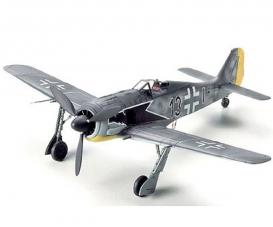
Model aircraft kits 1:72
Focke-Wulf Fw190 A-3
300060766€15.99
Article number: 300060766 Product: Focke Wulf Fw 190 A-3 Development of the FW190 series began in the Autumn of 1937, under a contract issued by the Reichsluftfahrtministerium (Air Ministry) for a single seat fighter to supplement the Messerschmitt Bf109. Two proposals were submitted by Kurt Tank, the technical director of the Focke-Wulf Flugzeugbau (aircraft factory). The proposal using the then new BMW 801 aircooled radial engine was chosen. This tough and powerful engine was placed in a robust airframe and provided superb handling, well balanced control, and brisk acceleration. It entered service in 1941, flying alongside the Bf 109 and it soon took control of air superiority over the English Channel. Establishing itself as a mainstay fighter of the Luftwaffe, it outperformed the contemporary Spitfire Mk.V's in almost every respect and maintained this advantage until the arrival of the Spitfire IX in July 1942. The Fw190 fighter underwent constant improvement throughout its life. The A-3 version used the improved BMW 801Dg engine that produced 1,700hp. Armament was increased from four to six guns, consisting of two rapid firing MG151's in the wing roots; two MG FF's outboard of the landing gear and two fuselage mounted MG 17 machine guns. Throughout WW2, many Luftwaffe squadrons allowed personal pilot markings and distinctive squadron insignia to be used, plus lower cowl, wing tip and rudder color additions to the original paint schemes. Detailed Plastic Kit of model Focke Wulf Fw 190 A-3 in scale 1:72 Warning! Not suitable for children under 14 years.
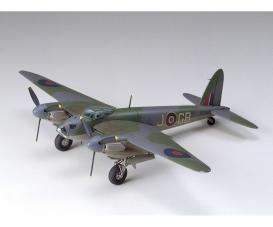
Model aircraft kits 1:72
Mosquito B Mk.IV/PR Mk.IV
300060753€23.49
Article number: 300060753 Product: 1:72 Mosquito B Mk.IV/PR Mk.IV The versatile Mosquito stood with the Spitfire fighter and Lancaster bomber and earned the respect of British pilots during World War II. In 1939, the De Havilland company envisioned the plane to be an unarmed high speed bomber, and had experience with the Comet, which was a wooden racing plane. Except for the engine and landing gear, the Mosquito was comprised of wood, offering strategic advantages. The wooden construction wold save on important metals such as aluminum, it could also be built in converted furniture factories. The Air Ministry was reluctant to adopt the wooden aircraft, but placed orders for 50 planes in March 1940 for reconnaissance use. In November 1940, the Mosquito reached speeds of 630km/h during test flights, demonstrating its potential and quickly prompting additional orders of 150 planes. The Mosquito PR Mk. I reconnaissance plane was first deployed in July 1941; the B Mk. IV bomber started deployment in the Spring of 1942. On May 31, 1942, the Mosquitoes led a daylight raid on Cairn. In September 1942, the Gestapo headquarters in Oslo was bombed. German officials delivering a daytime speech in Berlin were attacked on January 30, 1943. These events demonstrated the Mosquito's ability to carry heavy loads and deliver low altitude surprise attacks with accuracy. The camera equipped PR Mk. IV reconnaissance plane discovered the German Battleship Tirpitz in the Artic Circle and scouted V2 rocket facilities. The Mosquitoes performced their duties with minimal losses, displaying their remarkable abilities. Detailed Plastic Kit of model Mosquito B Mk.IV/PR Mk.IV in scale 1:72 Warning! Not suitable for children under 14 years.
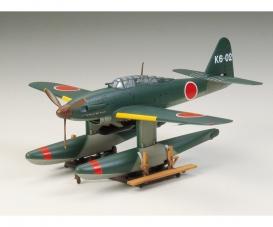
Model aircraft kits 1:72
SEIRAN
300060737€13.99
Article number: 300060737 Product: 1:72 SEIRAN This is a plastic model assembly kit of the Japanese Navy's special attacking machine, Harumi, developed for an unprecedented strategy of starting from catapult of a large submarine and launching a surprise attack. Faithfully reproduced a unique style fitted with a tightened nose or twin float equipped with an air-cooled engine. 800kg Movement dollies are also convenient for bombs and exhibitions. I printed a decal for the machine number of 6 aircraft. It would be interesting to explore the sunny storm that ended the war before the actual battle participation, by modeling its unknown ability. Detailed Plastic Kit of model SEIRAN in scale 1:72 Warning! Not suitable for children under 14 years.

Model aircraft kits 1:32
1:32 A6M2b Zero Model 21 (Zecke)
300060317€129.99
Article number: 300060317 Product: 1:32 Mits.A6M2b ZERO Fighter 21 About the Mitsubishi A6M2b Zero Fighter Model 21 (Zeke) The Japanese Zero Fighter plane was widely feared and respected by friend, foe and all who came into contact with it. A triumph of aerodynamic engineering and military science, the Zero Model 21 served in the skies across East Asia during early stages of World War II, contributing immensely to the Japanese war effort. It remains today an enduring symbol of that fierce and globe-spanning conflict. About the model •1/32 scale assembly kit of the Model 21 Zero Fighter. Length: 283mm, Width: 375mm. •Accurately reproduced curved cowling and fuselage are modeled from slide molding to accurately depict rivets and surface texture. •Realistically replicated Nakajima "Sakae" type 12 engine features propeller reduction unit, exhaust pipe and other detailed parts. •Both folded and extended wing tips included and can be used interchangeably even after assembly. •Durable and precision detailed metal parts depict landing gear system and pitot tube. •Seat belt incorporates photo-etched parts for extra realism. •Retractable landing gears increase display possibilities, while allowing model to be easily stored in package after assembly. •Features movable landing gears, rudder and flaps. •Includes standing and seated pilot figures and seven types of markings for planes which participated in Pearl Harbor attack. •Includes parts to depict any variation of Mitsubishi and Nakajima-built Zero Model 21. •Comes with wheel chocks and access steps. Includes posable display stand. Scope of delivery: Kit, instructions, decor Warning! Not suitable for children under 14 years.
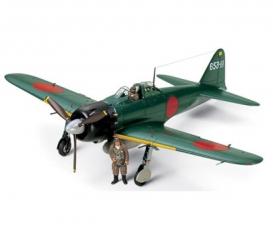
Model aircraft kits 1:32
1:32 A6M5 Zero Model 52 (Zecke)
300060318€129.99
Article number: 300060318 Product: 1:32 Mitsub.A6M5 Z.Fighter 1:32 scale aircraft offer all the details one would expect from such large models. Accurate detailing of the engine, instrument panel, seat or other cockpit area. Many metal parts have been used to make the product not only beautiful but also stable. Scope of delivery: Kit, instructions, decor Warning! Not suitable for children under 14 years.
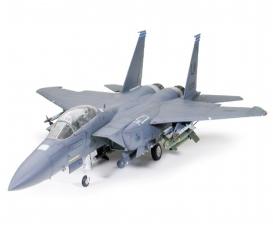
Model aircraft kits 1:32
1:32 Bo.F-15E Strike Eagle Bunker Buster
300060312€149.99
Article number: 300060312 Product: 1:32 Bo.F-15E Strike Eagle Bunker Buster About the Boeing F-15E Strike Eagle w/"Bunker Buster" The McDonnell Douglas F-15 Eagle is regarded as one of the most capable twin-engine air-superiority fighters in the world today. Ever since its maiden flight in July 1972, this record breaking Mach 2.5 fighter has been a yardstick for jet fighter design. In the early 1980's, the Air Force requested McDonnell Douglas to modify their F-15 fighter into a dual-role aircraft to be known as the F-15E "Strike Eagle" for use as an air-to-air fighter, and for air to ground attack missions. This new version was designed to penetrate deep into enemy territory unescorted, and strike military targets with pinpoint accuracy. The strike eagle employs two highly reliable Pratt & Whitney F100-PW-229 engines and was designed specifically as a two-person crew of pilot and weapons system officer. The LANTRIN (Low Altitude Navigation and Targeting Infra-Red for Night) system enables the Strike Eagle to operate at night and in bad weather. The Strike Eagle can also be employed with up to an 11-ton payload and can carry the GBU-28 Bunker Buster, a guided bomb developed to destroy strengthened underground bunkers. The Strike Eagle was first deployed in December 1989. During the Gulf War in 1991, 2 squadrons of 48 F-15E Strike Eagles demonstrated their power as multi-purpose fighter/attack planes. About the model The popular F-15E Strike Eagle (item 60302) was released in 1993. However, since this items release, the F-15E has come to be equipped with a variety of newly developed weapons systems. Following the changes in times and aviation fighting technology Tamiya has modernized its kit to feature accurate replicas of all the latest weapons systems employed by the F-15E Strike Eagle. Includes parts for replication of the GBU-28 "Bunker Buster", as well as AGM-130 and JDAM guided bombs, and ARAAM air-to-air missiles. 1/32 scale, total length 600, total width 404mm. Faithfully recreates intrepid form of Strike Eagle. Main parts such as fuselage and wings are to be fastened with screws.Radar unit/nose side-access panel, and Vulcan Cannon hatch can all be opened and closed after assembly. Canopy and air brakes can be assembled in either the up or down positions. Cockpit, radar, and Vulcan Cannon are all recreated down to the finest details. Each landing gear is brilliantly crafted in die-cast, and tires are fashioned with synthetic rubber.Each landing gear is brilliantly crafted in die-cast, and tires are fashioned with synthetic rubber. Scope of delivery: Kit, instructions, decor Warning! Not suitable for children under 14 years.
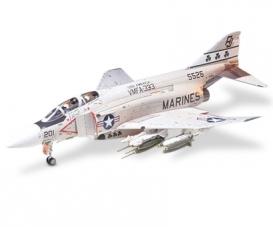
Model aircraft kits 1:32
1:32 F-4J PHANTOM II MARINES
300060308€139.99
Article number: 300060308 Product: 1:32 F-4J PHANTOM II MARINES About the McDonnell Douglas F-4J Phantom II Marines When test pilot Robert C. Little prepared to take off in the YF4H-1 prototype on May 27, 1958, few onlookers could have guessed at the success story yet to unfold. Over thirty years from that faithful day, the successors of that prototype, the Phantom series of aircraft, would be protecting the skies over the free world and see adoption by eleven nations including the U.S. Navy, Air Force and Marines. The Phantom II was developed by McDonnell Douglas and first pitted against Vought's F8U-3 Crusader III to see which aircraft would be the Navy's next main carrier-borne fighter. In 1959, the selection was made in favor of the robust Phantom II. The early production model, the F4H-1F, underwent various tests and training exercises, eventually leading to the F4H-1 model, which was deployed to several Navy and Marine divisions. In 1962, in efforts to unify the names of Navy and Air Force aircraft, the F4H-1F and F4H-1 became designated the F-4A and F-4B respectively. Just after its adoption by the Navy, the Phantom II showed the world what it was made of, breaking record after record, including top-speed, altitude, and time-to-climb. To top off these results, the U.S. Navy ran Project LANA, a transcontinental speed race. The roman L stood for the number 50, for "50th Anniversary of Naval Aviation". The contest was to demonstrate the Phantom's shocking speed and reach. Based on this impressive track record, and on comparative tests against Air Force fighters at the time, it was decided that the next main fighter of the Air Force would also be the Navy's Phantom II. The F-4B version was specially tailored to the needs of the Air Force, and became designated the F-4C. Further improvements to that aircraft resulted in the F-4D model. The Navy continued to make improvements to the Phantom II. Mounting the F-4B with an automatic carrier landing system, yet another variant, the F-4G was born. On May 27th, 1966, perhaps the best known of the Navy's Phantoms, the F-4J, made a successful maiden flight. It housed powerful General Electric J-29GE-10 turbo jet engines, the powered-up version of the J-29GE-8 engines used on the F-4B and F-4G. It was also fitted with an AN/AWG-10 radar on its fire-control system and an ASW-11 one-way data-link. Stronger landing gear of vacuum-melted steel fitted with wide tires were added to meet the strict sink rate requirements, and the top and bottom surfaces of the inner wings were slightly bulged out. The Navy's foremost requirement being improved takeoff and landing, the F-4J was added a slot to the stabilator leading edge, which provided tremendous down force at low speeds. This Phantom II was capable of carrying a maximum weapon load of about five tons, which gave it a truly powerful punch. Its main air-to-air armaments consisted of AIM-7 Sparrow and AIM-9 Sidewinder missiles and a 20mm gun pod. AGM-12 Bullpup and AGM-84 Harpoon air-to-surface missiles, as well as various bombs and rockets were also loaded in great numbers. In 1966, the 101st Fighter Squadron of the Navy became the first to be outfitted with the F-4J. Deployment to the Marines soon followed in 1967, with F-4J aircraft outfitting the 334th, 232nd, 235th, and 333rd Fighting Plane Squadrons. As the deployment of the F-4J to the Navy and Marines continued through 1967, U.S. involvement in the Vietnam War was getting deeper and deeper. Back in 1961, the U.S. government decided to send their troops to Vietnam to support the South Vietnamese government, but the chaos only worsened. It was the carrier-borne Phantom II that launched the air battle, engaging the MiGs of the North Vietnamese. In late May of 1968, F-4J aircraft from the Navy's 33rd and 102nd Fighter Squadrons arrived at the Gulf of Tonkin aboard the USS America. The Navy's Phantom II headed for North Vietnam for roles in bomber support and anti-MiG patrol. This jack-of-all-trades aircraft was equipped with Mk.82 bombs and Sidewinder missiles for self-defense, and often served as effective close support for the ground forces of the Marines. The service of the F-4J in Vietnam is highlighted by one particular episode. On September 11 1972, Major Thomas (Bear) Lasseter and Captain John D. Cummings of VMFA-333 "Shamrocks" shot down a MiG-21 near Hanoi, the only time in the war that a MiG was downed by a U.S. Marine aircraft. That F-4J was later downed by a SAM (surface-to-air missile), but the pilots were later rescued. The production of the F-4J ended in late 1972. However, because the development and deployment of its successors, the F-14 Tomcat and F/A-18 Hornet were late, about 250 F-4J planes were equipped with the latest fire control devices and engines, and later designated F-4S. These aircraft remained in Marine use until 1991. Battling in five major conflicts spanning over three decades, and breaking almost every conceivable aviation record, the highly versatile Phantom II earned a special place in warplane history. Scope of delivery: Kit, instructions, decor Warning! Not suitable for children under 14 years.
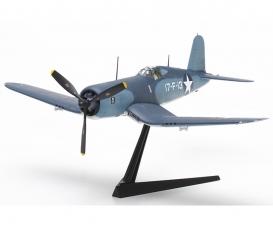
Model aircraft kits 1:32
1:32 F4U-1 Corsair "Birdcage"
300060324€134.99
Article number: 300060324 Product: 1:32 F4U-1 Corsair "Birdcage" The F4U-1 Corsair® was a truly unique aircraft, with a powerful 2,000hp engine and a massive 4m propeller, not to mention the highly characteristic inverted gullwings. In October of 1940, it was the first American fighter to achieve a speed of 400mph (around 640kph). Initial production models of the aircraft featured a striking canopy called the "Birdcage". The aircraft took part in operations from February 1943, and with its powerful 12.7mm machine guns proved to be a formidable opponent for the Japanese Zero Fighters. In order to capture the aircraft as accurately as possible, Tamiya designers not only inspected, measured and examined the real aircraft at five different museums across North America, they were also given access to Northrop-Grumman's blueprints. The result is a highly detailed and precise 1/32 scale model of the F4U-1 Corsair. Scope of delivery: Kit, instructions, decor Warning! Not suitable for children under 14 years.
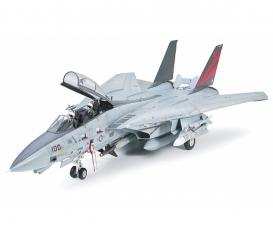
Model aircraft kits 1:32
1:32 Grumman F-14A Tomcat Black Knights
300060313€164.99
Article number: 300060313 Product: 1:32 Grumman F-14A Tomcat Black Knights About the Grumman F-14A Tomcat "Black Knights" Ever since its first flight in 1970, the U.S. Navy's F-14 Tomcat has been one of the best top Air Defense Fighter. From 1990, in addition to its role as an interceptor, the F-14A, noted for its long range and superior weapons systems was designated as an air-to-ground strike plane. With this new role, the Tomcat was fitted with a new weapons arsenal. Since 1996, the F-14A employs the AN/AAQ-14 targeting pod, referred to as the LANTIRN. This targeting pod gives the F-14A precision bombing capability by procuring targets for nose-mounted infrared laser or other laser guided weapons. The AN/AAQ-14 targeting pod contains a high-resolution, forward-looking infrared sensor (which displays an infrared image of the target to the pilot), a laser designator-rangefinder for precise delivery of laser-guided munitions, target tracking software, and more. The LANTIRN, combined with GBU-16 and GBU-24 guided bombs, enables precision striking with a minute margin of error from several meters down to tens of centimeters. This precision can be realized at long-range. The VF-154 Black Knights is attached to the USS Kittyhawk, homeported at Yokosuka Harbor, Japan. The Black Knights were formed after WWII, and were deployed to both the Korean and Vietnam War. F-14A were employed with the VF-154 from 1984, and used extensively in Operation Desert Shield during the Gulf War in 1990. About the model • Fighter-Bomber Grumman F-14A Tomcat plastic assembly kit. • 1/32 Scale •Overall length: 598mm, Overall width: 612mm. • The form of the aircraft has been accurately rendered. • Kit employs metallic parts and screws to make the wing movable. • A full range of armament including Phoenix missiles, GBU-16 and GBU-24 laser guided bombs are provided as well as a AN/AAQ-14 LANTIRN targeting pod. • Includes 3 figures, 2 pilots and a catapult officer, and decals for 5 aircraft. Warning! Not suitable for children under 14 years.
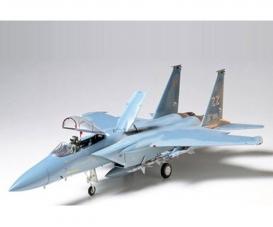
Model aircraft kits 1:32
1:32 Mc Donnell DOUGLAS F-15 EAGL
300060304€124.99
Art.Nr.: 300060304 Product: 1:32 Mc Donnell DOUGLAS F-15 EAGL About the McDonnell Douglas F-15C Eagle At one time during the missile boom years, the U.S. Air Force believed future air battles could be decided by air-to-air missiles rather than guns in the traditional dog-fighting manner. The need for air superiority weapons was relearned during the Vietnam Conflict and led to an Air Force requirement for an all-weather, single-seat, twin-engined fighter. This aircraft was to optimize counter-air operations. The U.S. Air Force requested several manufacturers to study and develop prototypes during the late 1960's under the FX program (Fighter Experimental). McDonnell Douglas was awarded a contract to develop the F-15 Eagle jet fighter in December 1969. The Eagle's advanced aerodynamic design greatly reduced drag at both the low and high lift configurations, and achieved superior maneuverability during varying flight conditions. Making its maiden flight in July 1972, it was deployed in November 1974 as the F-15A Eagle, and had been in active service since then. It is powered by two Pratt & Whitney F100 afterburning turbofan engines developed exclusively for the for the F-15, and is capable of speeds in the Mach 2.5 range. The F-15 can carry a heavy load of devastating weapons, including the internally mounted 20mm M61A-1 Vulcan cannon, with 940 rounds of ammo, the AIM-7 Sparrow radar guided missile and AIM9 Sidewinder short range air-to-air missile. In 1979 an upgraded version of the Eagle was introduced as the F-15C. One notable change was the increase in fuel capacity, but even more fuel was made possible by the conformal fuel tanks, which snuggle between the wings and up against the jet inlet ramps. This increase in fuel capacity enables the Eagle to expand long range operations, such as escorting AWACS and strike aircraft to their targets. The Landing gear has been reinforced to accept the extra fuel weight, allowing a maximum take-off weight of 68,000 lbs (30844 kg). The F100 Pratt & Whitney engines were also upgraded for easier maintenance and increased performance. The F-15C's maximum rate of climb at sea level is more than 50,000ft (15,240m) per minute. As the Premier jet fighter the Eagle continuously receives improvements to keep pace with the changing state of the art. The multi-stage improvement program (MSIP) is organized to enhance the avionics, like the internal ECM system and computer capacity. The APG-63, provides excellent long range navigation and tracking for the Eagles' fighter interdiction role. Owning to its versatility, adaptability and ruggedness, the F-15 Eagle will certainly continue to play its role of an air superiority fighter well into the 21st century. Scope of delivery: Kit, instructions, decor Warning! Not suitable for children under 14 years.
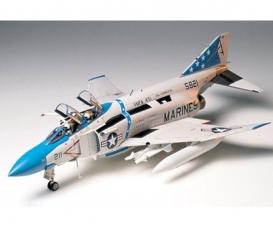
Model aircraft kits 1:32
1:32 Mc Donnell Douglas F-4J Phantom II
300060306€129.99
Article number: 300060306 Product: 1:32 Mc Donnell Douglas F-4J Phantom II Originally accepted for Navy service in 1958, the F-4 Phantom II went on to protect the skies of numerous Western nations. This kit depicts the F-4J variant which served with distinction with the Navy during the Vietnam War and was responsible for many victories over North Korean MiGs. The major assemblies are attached with screws and the one-piece fuselage and die-cast metal landing gear legs ensure superb strength. The canopy and air brake may be assembled in either open or closed positions as well. To top it off, an array of ordnance including Sparrow and Sidewinder missiles, two crew figures, and three marking options are also included. Scope of delivery: Kit, instructions, decor Warning! Not suitable for children under 14 years.

Model aircraft kits 1:32
1:32 Mc Donnell F4 C/D PHANTOM II
300060305€124.99
Article number: 300060305 Product: 1:32 Mc Donnell F4 C/D PHANTOM II The F-4 Phantom II was originally conceived as a carrier-borne fighter for the Navy in the late 1950s but was eventually also adapted by the Air Force and Marines in addition to the air forces of many other countries. This model kit can depict the first variant used by the Air Force, the F-4C, as well the subsequently upgraded F-4D. The kit features a one-piece fuselage for easy assembly and die-cast metal landing gear legs to ensure a stable stance after the kit is finished. The canopy and airbrake may be assembled in either open or closed positions. A wide range of ordnance, two crew figures, and three marking options are also included. Scope of delivery: Kit, instructions, decor Warning! Not suitable for children under 14 years.
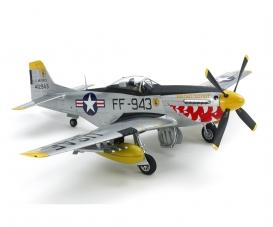
Model aircraft kits 1:32
1:32 N.A. F-51D Mustang Korean War
300060328€164.99
Article number: 300060328 Product: 1:32 N.A. F-51D Mustang Korean War ★This is a maiden appearance in detailed 1/32 for the F-51D Mustang that was deployed in hostilities during the Korean War. ★V12 engine is recreated with aplomb. ★Includes recreations of the squared-off propeller tips, two types of radio equipment, and other features that set this aircraft apart from late-WWII variants. ★Comes with parts for two kinds of drop tank, 500lb bombs and 5-inch HVAR rockets.
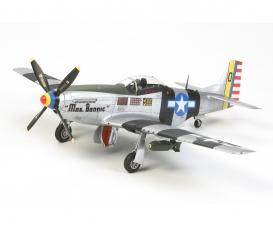
Model aircraft kits 1:32
1:32 P-51D / K Mustang Pacific
300060323€164.99
Article number: 300060323 Product: 1:32 P-51D / K Mustang Pacific The P-51D Mustang incorporated advanced features such as a laminar flow wing and an efficient radiator design, and powered by the Packard-built Rolls-Royce Merlin V-1650 engine, it demonstrated superior highaltitude performance. The P-51D was equipped with a Hamilton Standard propeller as standard but shortages of the propeller led to the installation of Aeroproducts propellers on some P-51Ds built at North American's Dallas factory, and these were distinguished by the designation P-51K. Most of the P-51Ks saw combat in the Pacific Theater, although some were also sent to Europe. In addition to the fighter role, some P-51s were equipped with cameras and used as reconnaissance aircraft. Such aircraft which were converted from P-51Ds and P-51Ks were designated F-6Ds and F-6Ks respectively. Scope of delivery: Kit, instructions, decor Warning! Not suitable for children under 14 years.
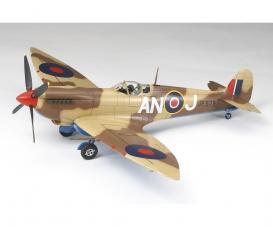
Model aircraft kits 1:32
1:32 Supermarine Spitfire Mk.VIII
300060320€154.99
Article number: 300060320 Product: 1:32 Supermarine Spitfire Mk.VIII The True Successor to the Mk.V The legendary Spitfire was the representative British fighter of WWII. Many variants were built and among these was the Mk.VIII, a variant developed to be the replacement for the RAF's previous mainstay Spitfire, the Mk.V. The Mk.VIII was fitted with a Rolls-Royce Merlin 60-series engine, larger radiators, and an air filter as standard. Other improvements included fuel tanks added in the wings, retractable tail wheel, shortened ailerons, and enlarged rudder and elevators. From the latter half of 1943, the Mk.VIII were deployed to the Mediterranean and Pacific Theaters and saw service with RAF, USAAF, RCAF, and RAAF units. About the Model 1/32 scale plastic assembly kit of the Spitfire Mk.VIII. ★Overall Length: 302mm, Overall Width: 383mm. ★Features of the Mk.VIII, including the retractable tail wheel, shortened ailerons, and wing fuel tanks, have all been accurately reproduced. ★You can select either retracted or deployed landing gear and tail wheel even after assembly. ★Parts to depict standard and extended wingtips included ★Features moveable ailerons, rudder, and elevators. Flaps can be depicted in either up or down position. ★Parts for 30 and 90 gallon fuel tanks included. ★Comes with 3 kinds of markings to depict the aircraft from USAAF, RAAF, and RCAF units. ★Comes with 2 pilot figures, 1 seated and 1 standing.
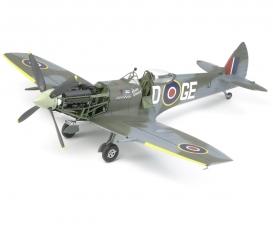
Model aircraft kits 1:32
1:32 Supermarine Spitfire Mk.XVIe
300060321€149.99
Article number: 300060321 Product: 1:32 Supermarine Spitfire Mk.XVIe A Case of a Good Bubble The legendary Supermarine Spitfire is often credited with saving England during WWII. Among its many variants was the Mk.XVI, which was a Mk.IX airframe that was powered by a Merlin 266 engine license-built by Packard Motor Car Company in the United States. Most Mk.XVIs featured the larger rudder and E Type wing with two 20mm cannons and two 12.7mm machine guns. With the introduction of the teardrop canopy, the rear upper fuel tank capacity was reduced to 33 gal. and that of the forward lower fuel tank was increased to 48 gal. to compensate. 1,054 Mk.XVIs were produced from September 1944 until July 1945. During the war, they were deployed on the European front and served as fighter-bombers. In the post-war period, the Mk.XVI was used by the RAF as well as the Belgian and Greek air forces until the early-1950s. About the Model 1/32 scale plastic assembly kit of the Spitfire Mk.XVIe. ★Overall Length: 302mm, Overall Width: 311mm. ★Distinctive features of the Mk.XVIe, including Packard Merlin 266 engine, E Type wing, teardrop canopy, and modified landing gear legs, are accurately reproduced. ★Canopy may be opened even after assembly. ★Features movable ailerons, rudder, and elevators. Flaps can be depicted in either up or down position. ★30 gallon drop tank, two 250lb bombs, and 3 types of markings included. ★Comes with 3 kinds of markings to depict the aircraft from Royal Air Force squadrons as well as the (Pilots) Refresher Flying Unit. ★2 pilot figures, 1 seated and 1 standing, are included. Scope of delivery: Kit, instructions, decor Warning! Not suitable for children under 14 years.

Model aircraft kits 1:32
1:32 US VOUGHT F4U-1A Corsair
300060325€154.99
Article number: 300060325 Product: 1:32 US VOUGHT F4U-1A Corsair This is a highly detailed model recreating the F4U-1A variant of the highly popular Corsair model. Newly-designed parts are included in the kit to accurately capture the modifications which distinguish it from the original F4U-1. The F4U-1A drew on the experience of Navy and US Marine Corps pilots' experience with the original aircraft, making modifications to further improve the performance of this legendary bird. One of the most noticeable alterations was the discarding of the "birdcage" cockpit and its extensive frame sections that hampered visibility; a semi-bubble canopy with minimal frame was installed instead, which improved the pilot's view and made it easier to land the F4U-1A. Additional upgrades included raising the pilot's seat 18cm to help with visibility, and later extending tail wheel struts by 16.5cm. A wedge shaped spoiler was added to the starboard wing to correct the tendency of the port wing to stall first and roll out of control. Such modifications contributed greatly to the F4U-1A's suitability for use from aircraft carriers; although by this time it had been passed over for that duty by the F6F Hellcat. Unlike its predecessor, the F4U-1A would later be used as fighter-bomber, and was given the capability of carrying a drop tank under the fuselage, plus a bomb rack for use on raids supporting ground troops. This combination of fearsome performance in the air and bombing capability made the F4U-1A a vital component as the Allied forces conducted their 'island hopping' strategy progressing through the Solomon Islands. Scope of delivery: Kit, instructions, decor Warning! Not suitable for children under 14 years.
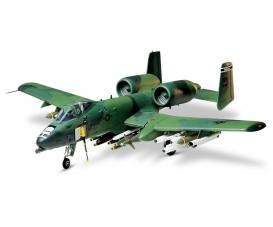
Model aircraft kits 1:48
1:48 Fairchild Republic A-10A Thunder.II
300061028€38.49
Article number: 300061028 Product: 1:48 Fairchild Republic A-10A Thunder.II About the Fairchild Republic A-10A "Thunderbolt II" The need for close air support, on small pin point targets, was recognized early during the Vietnam conflict. Following an experimental development program begun in the early 1970's, the Fairchild Republic Industries A-10 Thunderbolt II was selected for production. The performance characteristics demanded were for operation on unimproved short fields, both high and low airspeed maneuverability, easy maintenance, long loiter times and range, excellent pilot protection, and a capacity for large mixed weapons loads. The appearance of the A-10 is remarkable while its performance is amazing. Known affectionately as the "Wart Hog" by its pilots, it's a large single seat aircraft, identified by a pair of TF-34-100A high bypass fan jet engines mounted high near the rear of the twin tailed fuselage. A few of the specifications are: Length 53' 4"; height 14'8", span 57'6"; maximum gross weight 47,400lbs, including 16,000lbs of external stores. Internal armament is the GAU-8/A 30mm Gatling cannon capable of 2100 or 4200 rounds per minute. It carries 1350 rounds of ammunition, a fire control head-up display, CRT TV monitor, laser spot seeker plus a diversified armament panel that can facilitate any operational need. The A-10 has been around since 1972, and has again proven its worth during the recent Gulf war. Warning! Not suitable for children under 14 years.

Model aircraft kits 1:48
1:48 Ger. Fieseler FIL156C Storch
300061100€81.99
Article number: 300061100 Product: 1/48 WWII Dt. Fieseler FIL156C Storch About the Fi 156 Storch Produced to meet a Luftwaffe requirement for a new liaison aircraft, the Fi 156 Storch was a light aircraft that had amazing STOL (Short Take-Off and Landing) capabilities. The design incorporated such practical features as folding wings, which allowed it to be easily transported, and landing gear shock absorbers that allowed it to land on rough surfaces. It was used in a variety of roles, including liaison, tactical reconnaissance, and air ambulance, and it was the aircraft that was involved in the daring rescue of Italian dictator Benito Mussolini. Field Marshal Erwin Rommel was also known to make heavy use of his Fi 156 for battlefield reconnaissance in North Africa. About the Model •Highly-detailed 1/48 scale assembly kit model of the Fieseler Fi 156 Storch. •Kit includes parts to replicate various versions of the Fi 156C, including fuel tank, skis, and 3 different types of canopies. •Clear canopy sides have been molded together with the fuselage halves for more realistic construction. •Important structural sections such as the wing spar and the landing gear struts are made from metal parts for enhanced realism and strength. •Includes 1 pilot and 1 commander figure. •Precision photo-etched parts such as cockpit panels, cockpit frame, and front seat also included. Warning! Not suitable for children under 14 years.
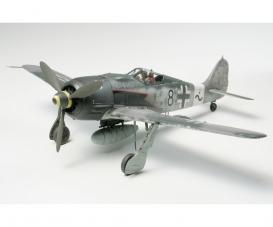
Model aircraft kits 1:48
1:48 Ger. Focke Wulf Fw190 A-8/A-8R2
300061095€38.49
Article number: 300061095 Product: 1:48 WWII Dt.Focke Wulf Fw190 A-8/A-8R2 Combating the Flying Fortresses In 1944, as the U.S. began their long range strategic bombing campaign in earnest with heavily-armed B-17 and B-24 bombers, the Luftwaffe developed the specialized "bomber-killer" R2 variant of the Fw190 A-8. Tamiya now brings you this formidable fighter in the 1/48 scale, and with all the parts included in this kit you can choose to build either the R2 variant or the A-8. About the Fw190 A-8/R2 The Focke-Wulf Fw190 was one of the Luftwaffe's best front-line fighters of WWII. Of all the different variants, the A-8 armed with four 20mm cannon and two 13mm machine guns was the most widely produced. A sub-variant of the A-8 was the R2, which had two of the 20mm cannons replaced by more powerful 30mm guns and added armor protection for its role in attacking the giant 4-engined Allied bombers. Warning! Not suitable for children under 14 years.
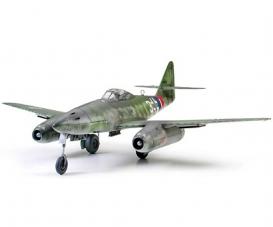
Model aircraft kits 1:48
1:48 Ger. Messerschmitt Me262 A-1A
300061087€44.99
Article number: 300061087 Product: 1:48 Ger. Messerschmitt Me262 A-1A About the Messerschmitt Me262 A-1a The revolutionary Messerschmitt Me262 was the first jet powered plane to see service. The construction of pre-production aircraft designated Me262 A-0 started in April 1944 but the fighter production version that should have been the first version to be mass-produced was delayed because of Hitler's strict contrary orders prioritizing the deployment of fighter/bomber A-2a version. Then, in November 1944, the Me262 A-1a fighter version was finally put into production. It was equipped with four 30mm cannons in the nose to counter Allied bombers and escorting fighters. Late production planes were equipped with hooks under the nose to mount rocket launchers and with 24 R4M air-to-air rocket under the wings making the Me262 the most feared German fighter by Allied pilots. About the model - Tamiya presents the plastic assembly kit of the Messerschmitt Me262 that was used by the Luftwaffe during the closing days of WWII. - 1/48 Scale, Overall Length: 221mm, Overall Width: 264mm. The unique form of the Me262 with its engine nacelles under each wing has been accurately replicated. - The 4 X 30mm cannon mounted in the nose and cockpit have been reproduced down to the finest details. Canopy and gun bay access panels can be mounted in either open or closed position. - R4M air-to-air rockets with launchers to be mounted under the wings and W.Gr 21 air-to-air rocket-launchers to be assembled under the nose are part of the kit. - Nose wheel well comes as a die-cast weight. - A pilot figure and decals for 4 different markings are included in the kit. Warning! Not suitable for children under 14 years.

Model aircraft kits 1:48
1:48 Ger. Nachtjäg. Heinkel Uhu He219
300061057€54.99
Article number: 300061057 Product: 1:48 Ger. Nachtjäg. Heinkel Uhu He219 The He 219 was arguably the Luftwaffe's best nightfighter during WWII and was notable for an extraordinary debut mission in June 1943 when a prototype shot down five RAF Lancaster bombers. This kit depicts the final production variant, the A-7, which was equipped with DB 603G engines for improved high-altitude performance. Distinctive features such as the slim fuselage, greenhouse-style canopy, and tricycle landing gear are all accurately reproduced. The cockpit interior even features an integrated nose weight to ensure the model stays balanced when displayed. Two crew figures and three marking options are also included.
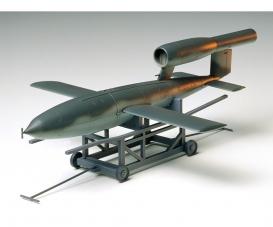
Model aircraft kits 1:48
1:48 Ger. V-1 Fiseler Fi103
300061052€14.49
Article number: 300061052 Product: 1:48 Ger. V-1 Fiseler Fi103 Powered by a pulse jet engine, the unmanned V-1 flying bomb developed by Germany during WWII would reach speeds of 640km/h, fly a certain distance, then crash and explode. This kit reproduces the simple form of this weapon and also includes parts to depict a transport trolley.
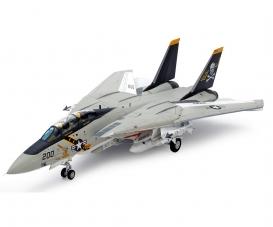
Model aircraft kits 1:48
1:48 Grumman F-14A Tomcat
300061114€104.99
Article number: 300061114 Product: 1:48 Grumman F-14A Tomcat The Definitive 1/48 Scale F-14A Tomcat From its first test flights in 1970 through to its retirement in 2006, the F-14 Tomcat is a carrier-based fighter that has captured the imagination; its variable sweep wing allowed automatic adjustment for optimum performance and an impressive combination of speed and manouverability. It had a powerful AN/AWG-9 fire control system that could use AIM-54 Phoenix missiles to take on multiple targets from range. 477 of the 632 Tomcats supplied to the U.S. Navy were the early F-14A variant; their delivery to units began with carrier squadrons in 1973, and its combat debut was in the 1975 evacuation from Saigon. It was later in action in conflicts in Libya, Iraq and Afghanistan. Seventy-nine F-14As were also supplied to Iran before the 1979 Islamic Revolution and some still remain in service today. About the Model ★This is a 1/48 scale plastic model assembly kit of the Grumman F-14A Tomcat. Fuselage length: 398mm, Maximum Wingspan: 408mm. ★Designed with access to real F-14A Tomcats for superlative accuracy. ★Features moving depiction of variable sweep wing. ★2 sets of parts - interchangeable after completion - depict sealing plates and air bags with wing in fully swept and fully forward positions. ★Slide molding was used to ensure highly realistic canopy, air intake side and fuselage side sections. ★Poly caps allow movement of horizontal stabilizers. ★The model offers a choice of parts to depict open or closed engine afterburner nozzles. ★Separate parts are included to depict the fuel probe on the right of the nose, and the ladder on the left. ★Comes with two U.S. marking schemes and one for the Islamic Republic of Iran Air Force. Warning! Not suitable for children under 14 years.
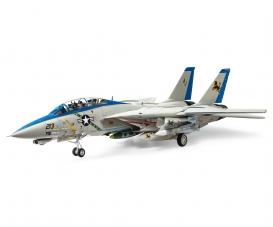
Model aircraft kits 1:48
1:48 Grumman F-14D Tomcat
300061118€114.99
Article number: 300061118 Product: 1:48 Grumman F-14D Tomcat • This is a 1/48 scale plastic model assembly kit. Fuselage length: 398mm, wingspan: 408mm (with variable sweep wing in fully forward position). • Tamiya designers spent many hours close up with real aircraft to obtain a highly accurate end product. • Captures F-14D-specific features such as the engine afterburner nozzles, vertical stabilizers and even minute panel lines. • A detailed cockpit includes depictions of updated instrument panels and ejection seats. • Model parts depict late variants of Phoenix, Sparrow and Sidewinder air-to-air missiles. Also included are parts for drop tank, laser- and GPS-guided bombs, LANTIRN targeting pod, TARPS reconnaissance pod and jamming pod – a comprehensive line-up. • Features moving depiction of variable sweep wing. 2 sets of parts - interchangeable after completion - depict sealing plates and air bags with wing in fully swept and fully forward positions. • Slide molding was used to ensure highly realistic canopy, air intake side and fuselage side sections. • Poly caps allow movement of horizontal stabilizers. • Comes with realistic figures depicting pilot and RIO (Radar Intercept Officer) in seated pose. • Includes high-quality decals to realize 4 (planned) marking options, plus a handy set of masking stickers for use when painting the canopy.

Model aircraft kits 1:48
1:48 Jap. A6 M5C Type 52 Zero Fighter
300061027€16.99
Article number: 300061027 Product: 1:48 Jap. A6 M5C Type 52 Zero Fighter About the A6M5c Type 52 Zero Fighter In April 1939, shortly after the first Japanese Zero began test trials, modification drawings were already taking place on the zero in the Mitsubishi design room, to keep pace with the anticipated long air war in the Pacific. After the initial superiority of the Zero over allied aircraft began to wane, due to new U.S. types being introduced, Mitsubishi was hard pressed to maintain a superiority. The introduction of the Grumman F6F and Chance Vought F4U, provided a need for more firepower, armor protection and capability led the combined companies of Nakajima and Mitsubishi to produce the A6M5 series of aircraft. Total production of the Type 52 series consisted of 10,449 aircraft of which Nakajima produced 6,570. It first entered combat in August 1943 at a time when the Japanese forces were withdrawing from previously held islands in the South Pacific. The type 52c was the last of the A6M5 series, and the most effective against Allied aircraft due to its armament configuration three of 13mm machine guns and two 20mm cannons. A total of 93 Type 52 and 52b zeros were field modified to "c" weapons configuration. The 7.7mm machine guns, housed in the cowling of the Zero since its first introduction, proved to be less effective during the latter stages of the conflict, due to the heavier armor protection of allied aircraft, and their self sealing fuel tanks. The 13mm weapon was greatly more effective; however, due to its increased weight, only one of them could be housed in the cowling and one in each wing. The 7.7 machine guns were removed from the cowling and one 13mm gun was mounted on the right hand side. This installation also made necessary the enlarging of the right hand projectile exit and cowling tube input, of the cowling, giving it an unbalanced look when viewed from the top.
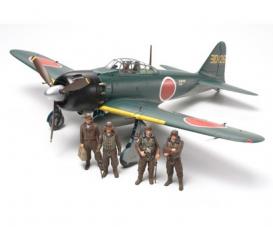
Model aircraft kits 1:48
1:48 Jap. Mitsub. A6M5/5a Zero Fighter
300061103€49.99
Article number: 300061103 Product: 1:48 WWII Jp.Mitsub.A6M5/5a Zero Fighter The Mitsubishi A6M Zero was the Japanese Navy’s main fighter throughout the course of WWII. In the latter half of the war, the Model 22 was refined to create the Model 52 to counter new U.S. aircraft such as the P-38 Lightning and F4U Corsair. It featured 50cm shorter wings with rounded wingtips, individual exhaust pipes and top speed of 565km/h. A6M5a was produced with a larger capacity (125 rounds) belt-type cannon ammunition system in February 1944. The Model 52 first saw action during the closing stages of the Solomons campaign in the autumn of 1943 and went on to fight in the skies above the Marianas, Iwo Jima, Okinawa, as well as Japan itself, until the end of the war. This is a 1/48 scale assembly plastic model of the Mitsubishi A6M5/5a Zero Fighter. ★Length=190mm, Width=229mm ★Zero fighter’s elongated proportions from nose to tail and the exquisite engine cowling are all accurately reproduced thanks to a complete measurement of the actual plane. ★Highly detailed cockpit and main landing gear well parts. ★Choice of an up or down flaps, as well as open or closed cowl flap. ★A6M5a with belt-type cannon ammunition system can be recreated. Differences from the A6M5 such as wing panels, spinner and wooden drop tank are highly detailed. ★3 types of markings are included. ★In addition to a sitting pilot figure, 4 different types of standing pilot figures are included.
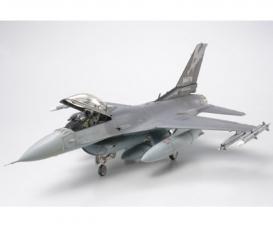
Model aircraft kits 1:48
1:48 Lockheed Martin F-16C Block 25/32
300061101€72.99
Article number: 300061101 Product: 1:48 Lockheed Martin F-16C Block 25/32 About the F-16C Block 25/32 The F-16 has become one of the most widely-used jet fighters in the world, and has therefore undergone a series of upgrades throughout its service life with various air forces. The Block 25entered service in 1984 and featured upgraded radar and cockpit avionics. The Block 32 was the first upgrade affected by a program to use different engines in the F-16, and continued to use Pratt & Whitney engines, while the Block 30 used engines made by General Electric. The Block 32 has been upgraded to carry a wide range of weapons, including the LITENING II laser targeting pod, which enables precision attack capability with laser-guided bombs. About the Model Model represents the F-16C [Block 25/32]. New parts accurately reproduce the correct engine nozzle and smaller air intake that correspond to Pratt & Whitney powered F-16s. Main landing gear and gear well covers also depicted with new parts. Wing reinforcement plates for Block 32 recreated with phot etch parts (sold seperatley). Extensive weapons set features AIM-9L/M and AIM-9X sidewinders, AIM-120 AMRAAM, wing and centerline fuel tanks, and LITENING II targeting pod. New parts for GBU-12 laser-guided bombs feature clear parts to depict the laser guidance package for a more realistic finish. New ordinance racks on the wings accurately match their respective weapons. 1 pilot figure included and 3 sets of U.S. Air National Guard markings included. Add ITEM 12621 F-16 Fighting Falcon Detail Up Parts Set for the ultimate finish. 1/48 F-16C ÄBlock 25/32Ü Warning! Not suitable for children under 14 years.
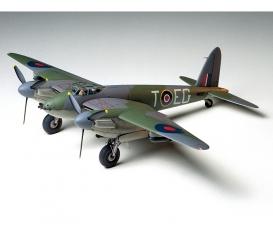
Model aircraft kits 1:48
1:48 RAF De Havilland Mosquito Mk.6
300061062€31.49
Article number: 300061062 Product: 1:48 RAF De Havilland Mosquito Mk.6 Nicknamed "The Wooden Wonder" due to its nearly all-wood construction, the de Havilland Mosquito was initially conceived as a fast, unarmed bomber and went on to serve in that and many other roles during WWII. This kit depicts the NF Mk.II nightfighter and FB Mk.VI fighter-bomber variants which were introduced in Spring 1942 and Spring 1943 respectively. Parts are included for the NF Mk.II's nose- and wing-mounted radar antenna as well as 500lb bombs and rockets for the FB Mk.VI. The bomb bay may be fitted with bombs and also features details for the fuel tank and 20mm cannon magazines. Two pilot figures and three marking options are included.
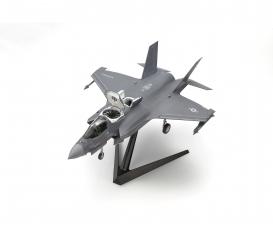
Model aircraft kits 1:48
1:48 US F-35B Lightning II
300061125€109.99
Article number: 300061125 Product: 1:48 US F-35B Lightning II Here comes another F-35 Lightning II variant, F-35B in our legendary 1/48 Aircraft Series. Developed under the Joint Strike Fighter (JSF) program, the F-35 integrates multiple functions into its design and there are three types: the F-35A conventional takeoff and landing (CTOL) aircraft, the F-35B short takeoff, vertical landing (STOVL), and the F-35C carrier takeoff and landing (CV). The F-35B was developed as a successor of the AV-8B Harrier II, and the U.K. - which along with the United States Marine Corps. employed many Harrier II -joined this program at early stage. The F-35B is recognized as the aircraft which accomplished both supersonic flight and STOVL by the 3-bearing engine duct nozzle and lift fan, and following the F-35A, the F-35B deployment started in 2015. The first F-35B to see action was an aircraft belonging to the U.S. Marine Corps VMFA-211 "Wake Island Avengers" in Afghanistan, in September 2018. Not only the U.S. and the U.K. but also Italy employs the F-35B, and the Japan Air Self-Defense Force also plans to launch a new fighter squadron with F-35B from 2024 onward. As the F-35B can be operated from both aircraft carriers and airfields featuring short runway, many countries are considering its deployment, and the F-35B looks set to become a significant presence in the skies across the world. Warning! Not suitable for children under 14 years.
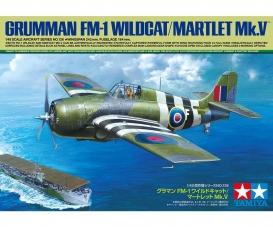
Model aircraft kits 1:48
1:48 US Grum. FM-1 Wildcat/Martlet Mk.V
300061126€37.99
Article number: 300061126 Product: 1:48 US Grum. FM-1 Wildcat/Martlet Mk.V Here comes more aircraft news! Tamiya welcomes the 1/48 Grumman FM-1 Wildcat/Martlet Mk.V™ in our legendary 1/48 Aircraft Series. Based upon our popular Item 61034 1/48 Grumman F4F-4 Wildcat, this kit authentically recreates the FM-1 featuring four machine guns with both the U.S. Navy and Royal Navy markings and one sitting pilot figure. The deployment of the Grumman F4F-3 Wildcat – one of the main U.S. Navy carrier-based fighter – started from 1940, and in 1942, the F4F-4 was introduced and this aircraft employed a foldable wing for efficient use on deck while 12.7mm machine guns were increased from four to six. With its bulletproofing, rigid fuselage and its pilots' tactics, the F4F-F was more than equal to the Zero fighter. Although the F4F-F gave its position to aircraft equipped with 2,000hp-class engine such as the F6F Hellcat and F4U Corsair after WWII onward, , this aircraft - which was suitable for use on small flight decks – constructed its presence as the aircraft to be deployed on escort carrier and to enhance air force. While the Grumman focused on the F6F production, Eastern Air Lines took over the production of the F4F-4 variant which was called as the FM and its first production variant FM-1 was mostly the same as the F4F-4 except for decreased (from six to four) machine guns. The Wildcat was introduced to the Royal Navy and was known as the Martlet (fictitious bird often seen in the English coats of arms). This aircraft continued to see action as anti-submarine patrol and convoy escort until the end of war. Warning! Not suitable for children under 14 years.
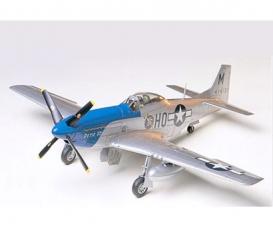
Model aircraft kits 1:48
1:48 US North American P-51D Mustang
300061040€29.99
Article number: 300061040 Product: 1:48 US North American P-51D Mustang About the North American P-51D Mustang 8th AF In April 1940, drawings were sketched in a New York City hotel room for a new fighter aircraft for the British purchasing Commission. This fighter, the North American NA73X, became one of the best fighter aircraft in the U.S. Army Airforce during World War II, and is known as the P-51 Mustang. Of the several variations of this famous fighter, the P-51D is generally accepted as the definitive Mustang and was the first production version with the "Bubble" canopy. More "D" model Mustangs were built than all other Mustang variants combined, with a total of 9,603 coming off production lines. 45 squadrons of the famed U.S. 8th Airforce, stationed in England were equipped with the P-51D, which could now escort and protect the heavy bombers all the way to and from targets on the European continent. There were several major changes that set the "D" apart form earlier Mustangs. One was the change from four .50 caliber machine guns to six, three in each wing. Another was to mount the guns upright which helped to eliminate a jamming tendency that occurred in the four gun system. Ammunition was increased to 400 rounds per inboard gun, and 270 rounds for each of the other four. Underwing pylons were strengthened to carry the 110 or 165 gallon auxiliary drop tanks or 1,000 lb bomb. P-51D Mustangs went to fight in the later Korean conflict and it last flew combat in 1956 in the deserts to the Middle East, when Israel used Spitfires, Messerschimitts and Mustangs together in the Mid East conflict. Warning! Not suitable for children under 14 years.
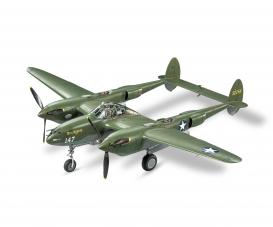
Model aircraft kits 1:48
1:48 US P-38 F:G Lightning
300061120€75.99
Article number: 300061120 Product: 1:48 US P-38 F:G Lightning Lighting Strikes! The P-38 Lightning was developed by Lockheed in response to a 1937 proposal from the United States Army Air Corps. Its twin V12 engines were housed one each in twin booms that stretched back to the tailplane, flanking a central nacelle containing the cockpit and weaponry. A combination of superb range, firepower and carrying capacity ensured that the P-38 was a superior fighter-bomber, and it made a considerable impact after joining fighting in Europe in 1942. It was also active in the Pacific War from late that year, its escapades including the shooting down of Japanese Admiral Isoroku Yamamoto in 1943 that provided a significant morale boost for the Allied cause. About the Model ★This is a 1/48 scale plastic model assembly kit. Length: 240mm, width: 330mm. ★Exhaustive studies of actual P-38 aircraft enabled this precise recreation of the distinctive twin boom aircraft form, with particular highlights being early model slimline engine cowlings, wing shape and rounded canopy design. ★Integrated landing gear bay and wing spar parts ensure sturdy assembly and accurate recreation of angle. ★Choose between P-38F and P-38G canopy designs, with each able to be assembled open or closed. ★The detailed cockpit features recreations of the control wheel, bulletproof glass plate, rear-mounted radio equipment and more. ★One-piece tailplane horizontal stabilizer slides on and is secured by rudder components. ★Metallic finish decals are used on main and nose landing gear strut cylinders. ★The nose has depictions of four 12.7mm machine guns and the 20mm cannon. ★Weights are included to ensure correct balance of the model when on display. ★Comes with a seated pilot figure, two marking options and an informative background information leaflet in four languages.
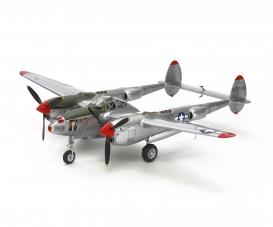
Model aircraft kits 1:48
1:48 US P-38 J Lightning
300061123€75.99
Article number: 300061123 Product: 1:48 US P-38 J Lightning Our legendary 1/48 Aircraft Series welcomes a new addition in the form of the J variant of the Lockheed P-38 Lightning! The Lockheed P-38 Lightning was an American twin engine fighter aircraft produced by Lockheed; it was the first Lockheed fighter aircraft which was officially adopted into service. The P-38’s variants were used during World War II and they reached about 10,000’s production. Equipped with intercoolers under engines, the P-38J Lightning showed 1,450hp at high altitude and maximum 1,600hp, plus longer range courtesy of fuel tanks in wingtip leading edges in addition to the main fuel tank. As a result, the P-38J offered stable and astonishing performance at any altitudes, and gained great renown among American fighter aircraft.
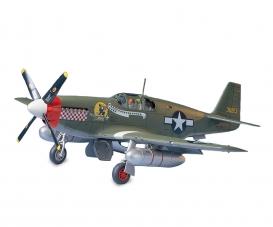
Model aircraft kits 1:48
1:48 US P-51B Mustang North Americ.
300061042€29.99
Article number: 300061042 Product: 1:48 US P-51B Mustang North Americ. About the North American P-51B Mustang The Allison engine powered P-51A Apache, was derived from the original RAF Mustang 1 ground attack and photo reconnaissance aircraft. Long before anyone had even heard of a Mustang, the plan to put a Rolls Royce Merlin engine into the airframe had started. The Merlin was powering some of the best warplanes in England; the Hurricane, Spitfire and the Avro Lancaster bomber. To develop a new engine for the P-51 would take considerable time, which the allies did not have. In September 1940, the Packard Motor Company of the U.S. began license production of the Merlin V-1650-1 engine in Detroit, Michigan. With a new supercharger drive, a new V-1650-3 was mated to the first P-51B. Both the U.S. and England started the Merlin engine modification idea almost simultaneously. 10 airframes were modified in the U.S. with the Merlin and these became the basis for the most successful fighter series of the war. Flying for the first time on 30 November 1942, the XP-51B was soon modified with a larger coolant radiator scoop, which actually increased its top speed by 50mph and gave it a higher ceiling by 10,000 ft. The addition of an 85 gallon fuel tank behind the seat increased the P-51B's already excellent range, and it could now escort the bombers all the way to the target and back. P-51B Mustangs began arriving in England in September 1943 with the first Mustangs going to the 3354th fighter group at Boxted, England, and ended the war with the most air to air victories. A total of 3788 P-51B's were produced. Warning! Not suitable for children under 14 years.
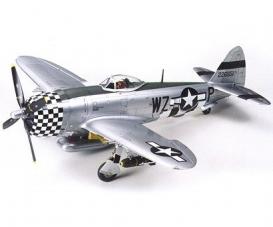
Model aircraft kits 1:48
1:48 US Rep. P-47D Thunderbolt Bubblet
300061090€47.99
Article number:300061090 Product: 1:48 US Rep. P-47D Thunderbolt Bubblet About the Republic P-47D Thunderbolt "Bubbletop" In May 1941, as the war raged in Europe, a single-engine fighter of more than 4t made its first flight. This fighter was the XP-47B, prototype of the Republic P-47 Thunderbolt of which a total of 15683 units will be built. Thanks to war experience, this aircraft was equipped with a 2000hp radial R-2800 engine, a supercharger and eight 12,7mm machine-guns. The XP-47B was to reach 633km/h and in January 1942, just after the USA went to war, the production of P-47B began. It was followed by the P-47C that incorporated various improvements and, from April 1943, by the P-47D, the most built version. The P-47D was equipped with an R-2800-59 engine, which can develop up to 2300hp with combat emergency water injection system engaged. The ducts that were passing on the sides and below the cockpit to connect the supercharger placed behind the pilot's seat gave to this plane its massive aspect. Many sub-types of the P-47D, designated D-1 to D-40, were produced but the first versions were called "Razorback" because of their sharp edge dorsal fin. The D-25 sub-type, which was introduced around June 1944, was fitted with an electrically actuated bubble canopy in order to improve pilot visibility and increased capacity fuel tanks. This decision resulted in a completely remodeled plane shape. All subsequent sub-types were also fitted with the bubble canopy and became a characteristic feature of late production Thunderbolts. The P-47 "Bubbletop" proved to be an excellent, well-balanced fighter-bomber. About the model - Republic P-47D Thunderbolt "Bubbletop" plastic assembly kit. - 1/48 scale, Overall length: 230mm, Overall width: 259mm. - This is the representation of P-47D late production that was nicknamed "Bubbletop". - The massive form of the plane, especially its belly and its cowling, has been accurately reproduced. - Flaps come as separate parts and can be attached in the up or down position. - Parts for replication of 3 types of mirrors, gun sights and 4 types of propellers are provided. - Engine cowling flaps and the intercooler air outlets on each side of the fuselage can be represented in the opened or closed position. - Parts for replication of 500-pound bombs, rocket launchers and 3 types of drop tanks are part of the kit. - A pilot figure and decals for two different markings are included. Warning! Not suitable for children under 14 years.
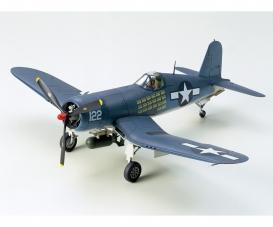
Model aircraft kits 1:48
1:48 US Vought F4U-1A Corsair
300061070€28.99
Article number: 300061070 Product: 1:48 US Vought F4U-1A Corsair About the Vought F4U-1A Corsair After enduring heavy losses to the Japanese Navy's Zero fighters in the early stages of the Pacific War, the U.S. Navy became focused on developing new fighters capable of turning the tides of aerial combat. Among those fighters was the Corsair, first developed to be a high speed, carrier borne aircraft. Built around the new Pratt & Whitney R-2800 2000hp engine, and turning the largest propeller ever attached to a fighter plane (4m dia.), this gull-winged wonder was destined to be a success. In June 1942, the F4U-1 production models made their maiden flight. However, due to their restricted forward field of view, and because of a propeller wash effect caused them to stall left wing first during low speed landings, they first were used as land based fighters. Succeeding the F4U-1 in the summer of 1943 was the F4U-1A, which was equipped with an extended rear wheel landing gear shaft, a slightly modified glazed canopy, and a small triangular strip of metal bolted to the right leading edge of the wing to equalize the stall and avoid the roll to the left at touch-down. Despite these improvements, the new F6F Hell Cat was adopted as the main carrier-borne aircraft, and the first combat Corsairs became relegated to land based US Marine squadrons in the South Pacific. Major Boyington and 2nd Lieutenant Hanson of the U.S. Marines, Lt. Kepford of the Navy and other ace-pilots, bravely flew the F4U-1A into fierce air-combats, overpowering the Japanese Zero fighters with tremendous top speed and six 12.7mm heavy machine guns. Warning! Not suitable for children under 14 years.
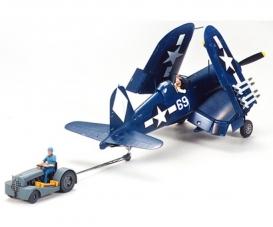
Model aircraft kits 1:48
1:48 US Vought F4U-1D Cors.w/ 'Moto-Tug'
300061085€46.99
Article number: 300061085 Product: 1:48 US Vought F4U-1D Cors.w/ 'Moto-Tug' About the Vought F4U-1D Corsair w/ Moto-Tug The speedy Corsair debuted as the 1st US fighter plane to overcome the 400mph (644km/h) barrier. However the initial production version of this aircraft, the F4U-1 "Birdcage", was not without its problems. The port wing stall often gave the Corsair unstable landing, and the long nose and framed canopy hindered visibility. These weak points necessitated the development of improved versions such as the latter developed F4U-1A with 18cm raised cockpit and raised rear landing gear. The F4U-1D featured clear vision canopy (two side frames removed) and had two pylons under the center wing section that could carry up to a 1,000lb bomb payload. In 1944 the F4U-1D Corsair was formally deployed as a carrier based aircraft. Following the successful release of the 1/48 Messerschmitt Me262 A-2a w/ Kettenkraftrad, Tamiya is proud to present yet another aircraft/ground vehicle set: the 1/48 scale F4U-1D Corsair (Item 61061) with the all new 1/48 "Moto Tug." This kit is perfect for designing the ultimate U.S. Navy Scene Diorama. Aircraft Tug or "Moto-Tug" tractors, as they were nicknamed, were manufactured by Ford. The Ferguson Company modified these vehicles for ease of application in the U.S. Navy by lowering clearance, and reducing wheel diameter to make it more compact. A protective panel was also added. The double-tire version of this vehicle was the BNO-40, the single-tire version was the BNO-25. Tow bars from Moto Tugs would attach to the rear landing gear or main landing gear struts. These vehicles were active in towing U.S. Naval planes to runways and hangers. The kit will feature all new parts for recreation of rockets on outer section of wing, perfect for displaying in wing-folded position. In addition to the standing pilot figure of the previous kit, a pilot figure to be assembled leaning out of the cockpit (checking towing) will be included. This kit reproduces the double-wheel version of the "Moto-Tug" with minimal parts for ease of assembly. Currently, decals for the replication of three different planes are planned to be included in this kit. Driver figure as well as two types of tow bars (main landing gear strut type and rear landing gear strut type) for "Moto-Tug" will also be included. Warning! Not suitable for children under 14 years.
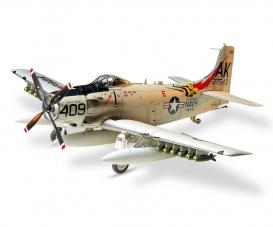
Model aircraft kits 1:48
1:48 USN Douglas A1-H Skyraider
300061058€39.99
Article number: 300061058 Product: 1:48 USN Douglas A1-H Skyraider About Douglas A-1H Skyraider U.S. Navy During 1943 the U.S. Bureau of Aeronautics considered to combine the tasks of torpedo bomber and dive-bomber into one. Several aircraft manufacturers, such as Douglas and Martin, were requested to develop a large, single-seat attack aircraft. According to the requirement, Douglas Skyraider, was developed by Douglas Aircraft Company, Inc. The development was started in early July 1944, and all night efforts of engineers made the first prototype's first flight possible already on March 18, 1945. Despite the short period of the development, flight trials proved the airframe's flight characteristics satisfactory and the aircraft was rated very highly. In May 1945 a letter of intent for 598 production was signed. The name "Skyraider" was officially approved for the aircraft in February of the following year, and the distribution to units was started at the end of the same year. The Skyraider was powered by Wright R3350 radial engine yielding 2,800 horse power and equipped with three large dive brakes on the fuselage. The Skyraider had a number of types, from the AD-1 to AD-7, recording grand total number of production of more than 3,000. Among them, AD-6 was the most produced variant. The AD designation for the Skyraider was changed in 1962, and the AD-6 became the A-1H. Noted for its durability and a large capacity for external stores, the Skyraider was well liked by its pilots and crewmen. Warning! Not suitable for children under 14 years.
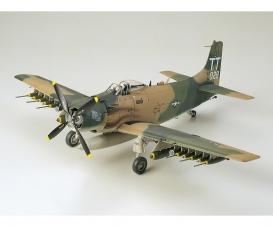
Model aircraft kits 1:48
1:48 WWII Douglas A-1J Skyrider USAF
300061073€43.99
Article number: 300061073 Product: 1:48 WWII Douglas A-1J Skyrider USAF About the Douglas A-1J Skyraider U.S. Air Force Also going by the names Dauntless II, AD, A-1 Able Dog, and Spad, the Douglas Skyraider saw almost 30 years of service. The Skyraider's development started in June 1944. Not completed in time for WWII, its first combat came with the outbreak of the Korean War in June 1950. The first production version to roll out of the Douglas factory was designated the AD-1. Twelve years and seven versions later, over 3200 Skyraiders had been produced. Among those, the AD-6 version, also known as "Able Dog Six", was produced in the greatest numbers. The next and final version of the Skyraider, the AD-7, was extremely identical to the AD-6, but it had reinforced wing spars and wing fittings, as well as the strongest landing gear of all the variants. The AD-7 housed the new wright R-3350-26WB engine, which enabled a top speed of 285 knots. Due to a directive to standardize the designation of Navy and Air Force aircraft, AD-6 and AD-7 became known as A-1H and A-1J respectively. In 1965, when U.S. air operations in Vietnam became more aggressive, literally hundreds of Skyraiders, including the A-1J, were deployed to the 14th and 56th Special Operations Wings (SOW). Armed with Mk.82 and Mk.117 bombs, 20mm wing-mounted cannons, and rocket launchers, the Skyraiders were used in a wide variety of combat missions.
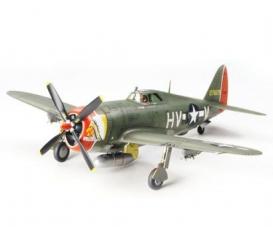
Model aircraft kits 1:48
1:48 WWII US Re.P-47D Thunderb.Razorback
300061086€47.99
Article number: 300061086 Product: 1:48 US Re. P-47D Thunderb. Razorback In 1943, the 8th Air Force was launching raids on Germany with its B17 and B24 from England. The aim was to destroy German main production factories. Unfortunately, losses during theses missions were very heavy and it became urgent to develop a fighter able to escort the bombers over enemy soil. The limited ranges of the Spitfire and P-38 Lightning did not make these fighters able to go further than Paris, leaving the bombers alone to fend for themselves for the rest of the flight. With the development of the P-47, this problem was overcome. The P-47 was the first single-seated fighter to be equipped with a supercharger, allowing it to fly at the same high altitude as the bombers. This high-flying fighter was armed with eight 12.7mm machineguns that proved very useful in the intense fighting that occurred in the European skies. Equipped with drop tanks for longer range, the P-47D was then able to escort the bombers all the way to the German border. The Thunderbolt also allowed many Allied pilots to become Aces. Bomber crews plagued day after day by intensive German interceptions, would remark that the presence of the P-47 was of great help. Warning! Not suitable for children under 14 years.
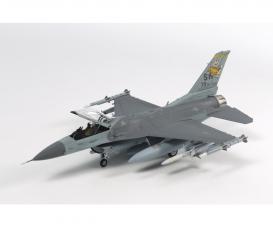
Model aircraft kits 1:72
1:72 F-16CJ w/FULL EQUIPMENT
300060788€42.99
Article number: 300060788 Product: 1/72 F-16CJ w/FULL EQUIPMENT This is the second release of the 1/72 scale F-16CJ [Block 50] Fighting Falcon (original Tamiya release: Item 60786) now with parts depicting underside equipment used on the aircraft! The versatile F-16 Fighting Falcon's adaptability to both air-to-air and air-to-ground missions makes it one of the cornerstones of the U.S. Air Force today. Block 50 evolutions of the aircraft were deployed from 1991, F-16CJ fighters being fitted with radar countermeasures. The aircraft's capabilities were extended yet further via the CCIP program, which gave night fighter functionality and more. Equipment depicted using new parts Centerline fuel tank Wing underside fuel tanks ECM counter measures pod AGM-88 HARM missiles AN/ASQ-213 HTS targeting pod AIM-120 AMRAAM missiles AIM-9M & -9X Sidewinder missiles AN/AAQ-33 Sniper XR pod Warning! Not suitable for children under 14 years.
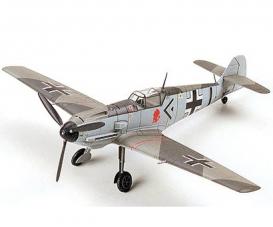
Model aircraft kits 1:72
1:72 Ger. Messerschmitt Bf109E-3
300060750€15.99
Article number: 300060750 Product 1:72 Ger. Messerschmitt Bf109E-3 Without a doubt, the Messerschmitt Bf109 can be clamed as the most famous and successful German aircraft from the WW2. It was the world´s most advanced fighter at that time of its debut in 1936, and remained as the standard fighter for the Luftwaffe throughout the conflict. Created by the brilliant designer Willi Messerschmitt, it had the smallest possible air frame built around the most powerful engine available. It also boasted many of the then innovated features such as an all metal stressed skin construction, retractable main landing gear. Automatic Handley-Page leading edge slats, etc. The Bf109 saw the first combat during the Spanish Civil War and fully demonstrated it exceptional maneuverability, inherited from its precedent Bf108 Taifun (Typhoon) multi-purpose sports plane. The Bf109 underwent numerous improvements throughout its carrier, and mass production of the E variant started late in 1939. Within one year, about 2,000 "E" aircraft were rolled out. Its excellent performance greatly contributed in the active service of German pilots at the Western Front and during the "Battle of Britain". The E-3 version used and improved Daimler-Benz DB601Aa engine capable of 1,100 h.p. output. This engine had provision for mounting a 20mm MG FF cannon on the crankcase and firing through propeller hub. The Messerschmitt Bf109E was one of the best fighters of the early WW2 period, on a par with the British Spitfire. Detailed Plastic Kit of model Messerschmitt Bf109E-3 in scale 1:72 Warning! Not suitable for children under 14 years.

Model aircraft kits 1:72
1:72 Jap. Mitsubishi A6M5 Zero Fighter
300060779€23.49
Article number: 300060779 Product: 1:72 Jap. Mitsubishi A6M5 Zero Fighter This is the definitive 1/72 plastic model of the Japanese Navy's representative fighter aircraft, the Mitsubishi A6M5 Zero Fighter. History of the Zero fighter: The Mitsubishi A6M Zero was the Japanese Navy's main fighter throughout the Pacific Theater during WWII. In the latter half of the war, the model 52 Zero, a refined version of the model 22, aimed to take on the ever increasing numbers of high-performance U.S. aircraft. It featured a shorter 11m wingspan with rounded wingtips, was powered by the same 1130hp Nakajima "Sakae" engine as seen in the model 22 Zero, and had the new exhaust propulsion system which gave it a 565km/h top speed. The A6M5 came armed with two 7.7mm machine guns and 20mm belt-fed cannons. Deployment of the A6M5 began in the autumn of 1943, and they saw action in the Solomons campaign as well as over the Marianas. It defended Japan against overwhelming numbers of superior U.S. aircraft up until the very last day of the war.
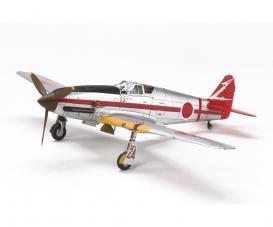
Model aircraft kits 1:72
1:72 Ki-61-Id Hien
300060789€25.49
Article number: 300060789 Product: 1:72 Ki-61-Id Hien This scale plastic model kit accurately depicts the Kawasaki Ki-61-Id Hien. The Hien was officially adopted by the Imperial Japanese Army in 1943, and stood out among its Japanese aircraft contemporaries in the Pacific War on account of its liquid-cooled Ha-40 engine, slimline fuselage and long, elegant wing. A number of different variants were produced, among them the Ki-61-Id which featured a 20cm-elongated nose to house 20mm cannons, plus 12.7mm machine guns in the wing. In fact, with 1,360 units it was the most prolifically produced Hien variant; its superior performance at higher altitudes meant that it was often given the brief of taking on incoming U.S. B29 bombers in the skies around the home islands of Japan.
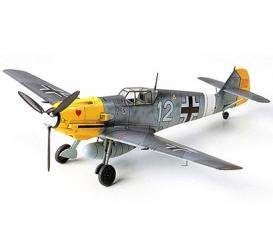
Model aircraft kits 1:72
1:72 ME-BF 109E-4/7 TRUP
300060755€17.29
Article number: 300060755 Product: 1:72 ME-BF 109E-4/7 TRUP During the first half of the Second World War, the Messerschmitt Bf109 E was the main fighter of the German airforce. The E-4 housed a 1,100hp Daimler Benz DB 601Aa engine and was armed with two 7.92mm machine guns on the nose, as well as a 20mm cannon on each wing. For some aircraft, bullet-proof glass was used to reinforce the front of the canopy. In addition, a 20mm canon, which ran through a tube in the propeller was supposed to be installed but was unsuccessful. Displaying superb acceleration and diving ability, the E-type planes overpowered the RAF's Hawker hurricane and equaled the Spitfire fighters in the Battle of Britain. However, with a flight range of only 560km, the E-4 planes were limited to just fifteen minutes of combat over British skies. Thus, the bombers were not given sufficient support and sustained heavy damage. As a result, the Luftwaffe's strategy to bomb England into surrender ended in failure. To deal with this drawback, the E-4 planes were equipped with additional 300L fuel tank. These improved fighters, called E-7, were first deployed at the end of 1940. After the Battle of Britain, the E-4/7 planes were sent to the front lines of Northern Africa. As the Bf109 F-type fighter's production was advanced, the E-4/7 was retired from the front lines. However, some veteran pilots continued to use the E-4/7 mainly for ground support duty until the summer of 1942. Bf109E-4/7 TROP Warning! Not suitable for children under 14 years.
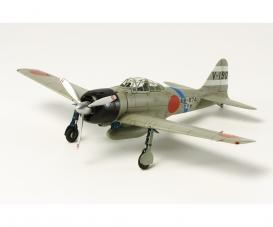
Model aircraft kits 1:72
1:72 Mits. A6M3 Zero Fighter Mo. 32 Hamp
300060784€21.99
Article number.: 300060784 Product: 1:72 Mits. A6M3 Zero Fighter Mo. 32 Hamp The 1/72 scale Warbirds Collection welcomes the A6M3 Zero fighter Model 32, which was codenamed ‘Hamp’ by American forces. The Model 32 was an evolution of the Model 21; it received an improved Sakae 21 engine and shorter, redesigned main wing, with the effect that its top speed increased by 11km/h and it also had improved roll and diving speed, albeit at the cost of increased fuel consumption. In fact, this plus with the Model 32’s smaller fuel tank meant its range was some 1,000km shorter. The Model 32 made its maiden flight on July 15th 1941, and first saw service with the 2nd Fighter Group in Rabaul, the Philippines. All told, 343 Model 32 aircraft were manufactured, a number so low in part due to the range limitations of the aircraft. About the Model • This is a 1/72 scale plastic model assembly kit. • The model faithfully replicates the form of the A6M3 Zero Model 32 with square-shaped wings. • Main wing, fuselage, and engine cowl are all newly-designed parts. • Features such as flaps integrated with wing parts make this model easy to build while still retaining an excellent grasp of the aircraft’s details. • 3 sets of markings included.

Model aircraft kits 1:72
1:72 US F-16CJ Fighting Falcon
300060786€30.99
Article number: 300060786 Product: 1:72 US F-16CJ Fighting Falcon The Lockheed Martin F-16 Fighting Falcon is a single-engine multirole fighter aircraft originally developed by General Dynamics for the United States Air Force (USAF). It was designed as an air superiority day fighter and later it evolved into a successful all-weather multirole aircraft. As of 2012, over 4,500 aircraft have been built since production was approved in 1976. In 2004 and in 2008 Tamiya’s model designers captured this iconic fighter in 1/48 scale and in 1/32 scale respectively, which both models received tremendous accolades from the modeling community and the industry press. The third release continues Tamiya’s tradition of excellence with this 1/72 cale model. This version is specifically of the F-16CJ (Block50) and it shares some of the same level of details as its larger counterparts. It is the perfect scale model for modelers confined to smaller display areas to show off their hard modeling work.
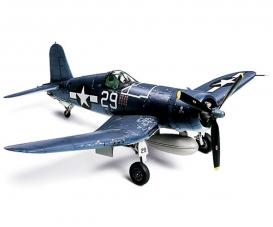
Model aircraft kits 1:72
1:72 Vought F4U-1A Corsair
300060775€24.49
Article number: 300060775 Product: 1/72 Vought F4U-1A Corsair About the Vought F4U-1A Corsair Introduced into service in 1942, the Vought F4U-1 featured inverted gull wings and a massive 2,000hp engine spinning the largest propeller mounted on a fighter at the time. While the fighter's performance and toughness was quite impressive, deficiencies such as inadequate forward visibility, restricted all-round visibility due to the early frame-like canopy, and the tendency for the left and right wings to stall at different speeds led to various improvements being added throughout production, eventually resulting in the F4U-1A version. These improvements included a longer tailwheel leg for better forward visibility, a new canopy for better all-round visibility, and an almost unnoticeable 15cm stall strip fixed to the leading edge of the right wing to ensure both wings would stall at the same speed. About the Model •1/72 scale assembly model kit of the Vought F4U-1A Corsair •Kit depicts a final F4U-1A Corsair production version with all improvements or versions at different stages of the improvement process. •Parts for 1000lb. bomb, external fuel tank, two types of propellers, and two types of tailwheel are included to provide many modelling possibilities •High quality decals for 3 different sets of markings Vought F4U-1A Corsair Warning! Not suitable for children under 14 years.

Model aircraft kits 1:72
De Havilland Mosquito FB Mk.VI
300060747€23.49
Article number: 300060747 Product: De Havilland Mosquito FB Mk.VI The De Havilland "Mosquito" made of wood was designed based on "high-speed bomber shaking off fighter". The design of the Mosquito was got in shape in 1939. The De Havilland had experienced producing "DH88 Comet" made of wood before, therefore they paid attention that the surface of wooden wing could be finished smoothly and the amount of aluminum could be saved. Two of Rolls Royce Merlin engines were selected as the source of power and the wood was used as the material of this fuselage. The parts with the metal were only the parts of the periphery of the engine and the landing gear. At the first time, the Air Ministry was passive adopting the Mosquito because of wooden and no machine guns. However the Mosquito made a maiden flight with the maximum speed of 630km when the "Spitfire" had the maximum speed of 580km at those time. Therefore a lot of "Mosquito" were suddenly requested. After many types of the Mosquito were produced, Night-Fighter Mk. II armed with 7.7mm machine guns on its nose and A.I.Mk.IV radar made an appearance. This Mosquito brought its ability into full play in attacking an airfield and intercepting raiding bombers. Also Fighting Bomber Mk. VI armed with four 225kg bombs and eight of rocket bombs was arranged as the actual fighting in Mar. 1943. This type played havoc with theland forces, the battleships and the U-boat. Furthermore it was active in attacking the railroad and its bridge at Burmese front line, giving a blow to Japanese army. The mosquito's wooden structure was strong against being shot, therefore it held an established position from the pilots with the special mission. Detailed Plastic Kit of model De Havilland Mosquito FB Mk.IV in scale 1:72 Warning! Not suitable for children under 14 years.

Model aircraft kits 1:72
P-47D Thunderbolt Bubbletop
300060770€21.99
Article number: 300060770 Product: 1/72 P-47D Thunderbolt Bubbletop About the P-47D Thunderbolt One of the most famous planes of WWII, the P-47D Thunderbolt was an outstanding single seat fighter plane excelling in high-altitude bomber escort and low-altitude ground attack. The P-47D featured a turbo-supercharged engine and was active on both the European and Pacific fronts. To solve the problem of insufficient visibility of earlier models, later Thunderbolt models were redesigned with a transparent bubble canopy, leading to the birth of the "Bubbletop". About the Model •Following the successful release of the P-47D "Razorback", Tamiya now introduces its successor, the "Bubbletop" to the 1/72 scale War Bird Collection. •At just 153mm it is the perfect size for collecting •Fuselage and canopy designed with all new parts to accurately represent bulky size •Loads of accessories including 500 pound bombs and M10 rocket launchers •Decals for 2 types of markings, including the 8th Air Force, 78th Fighter Group. Warning! Not suitable for children under 14 years.

Model aircraft kits 1:72
P-47D Thunderbolt Razorback
300060769€21.99
Article number: 300060769 Product: 1/72 P-47D Thunderbolt Razorback The P-47 was the first single-seated fighter to be equipped with a supercharger paired with a 2000hp engine, allowing it to fly at the same high altitude as bombers. Armed with eight 12.7mm machineguns, the Thunderbolt, with the P-51 Mustang, constituted the main fighters of the US Army Air Force. This is the representation of P-47D early production that was nicknamed "razorback" because of the shape of its upper fuselage behind the cockpit. The P-47D was a high-speed, high-altitude capable fighter and escorted the allied bombers that were conducting raids over Germany. Its 1-ton payload and its robustness made the Thunderbolt the perfect aircraft for ground attacking missions. About the Model •Sharp design of rear fuselage accurately reproduced. •Unique belly shape perfectly replicated thanks to left-right symmetrical construction. • Joining beams used to attach wings to fuselage, ensuring accurate wing angle. •Loads of accessories including 2 x 108 gallon tanks, 2 x 500 pound bombs and 2 x M10 rocket launchers. •For extra accuracy, kit comes with two different propellers to match decal markings. •Decals for 2 fighter groups, including one from Europe and one from the Pacific. Warning! Not suitable for children under 14 years.

Model aircraft kits 1:72
Skyray
300060741€14.49
Article number: 300060741 Product: 1/72 Skyray Towards the end of World War II, many information about advanced aeronautical technology were captured in Germany by the U.S. Forces. One of them was an analysis of the studies carried out by Dr. Alexander Lippisch on delta winged aircraft. Based upon the information, the Douglas firm developed the F4D Skyray, the only operational interceptor with delta wings in the U.S. Navy. Starting the design in 1947, Douglas was awarded a contract for the construction and testing of two prototypes in December 1948. The first prototype took off on its maiden flight in January 1951. The second prototype flew shortly thereafter, and the airframe set two new world records, absolute speed record of 1,211 km/h and 100km closed course record of 1,171km/h, in October 1953. Having numerous improvements and refinements, the first production F4D-1 made its maiden flight in June 1954 and entered squadren service in April 1956. The distinctive 50 degree sweptback wings with round tips were equipped with leading edge slats and trailing edge elevons. A set of trimmers were installed on the inboard trailing edges of the wings. The outer portions of the wings could be folded upwards by oil pressure for carrier stowage. Although the Skyray never saw any combat, it proved its high capability as an interceptor with numerous world records and scramble actions in Taiwan in response to crises in the late 1950's. Detailed Plastic Kit of model Skyray in scale 1:72 Warning! Not suitable for children under 14 years.
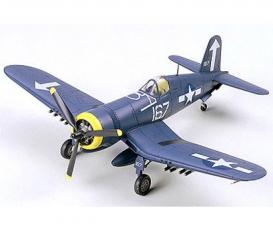
Model aircraft kits 1:72
Vought F4U-1D Corsair
300060752€21.49
Article number: 300060752 Product: 1:72 Vought F4U-1D Corsair Designed around the new Pratt & Whitney 2,000HP radial engine and tuning the largest propeller ever attached to a fighter plane, the Vought F4U Corsair became a legend in its own time. The F4U-1 was the first production version of the Corsair. It had an inverted gull wing and a production version of the Corsair. It had an inverted gull wing and a framed canopy with a flat top. However may problems were found soon. For example, the port wing stall often gave the Corsair unstable landing. Anther problem was poor visibility because of its long nose and framed canopy. Therefore F4U-1A: the cockpit was raised about seven inches, the framed canopy was replaced with a semi-bubble design canopy, and the taller tail wheel strut was equipped; was introduced. F4U-1D with clear vision canopy on frameless was introduced later for more visibility. Also the F4U-1D had two pylons under the center wing section that could carry the bombs up to 1,000 ponds and the napalm. Furthermore 5 inch rockets could be carried under each wing. Therefore in1944, the F4U-1D was formally deployed as the first carrier based aircraft of Corsair series. Beginning by placing the F4U 1D as Marine squadrons VMF-124 and VMF 213 aboard the ESSEX on the way to the Phillippines, the F4U-1D was used for attacking Japan as the first operation from U.S. Navy in 1945. About 3,700 amounts of F4U-1D were produced, then it held an established position from U.S. Navy because of its ability and reliance. Detailed Plastic Kit of model Vought F4U-1D Corsair in scale 1:72 Warning! Not suitable for children under 14 years.
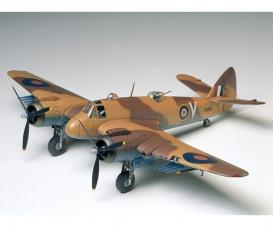
Model aircraft kits 1:48
1:48 Bristol Beaufighter Mk.6
300061053soon available again
Article number: 300061053 Product: 1:48 BRISTOL BEAUFIGHTER MK.6 About the Bristol Beaufighter Mk.VI Bristrol's "Beaufighter" was one of the most successful and widely used twin engines fighter types during WW2. The first series production Beaufighter MK.1 entered service in September 1940. With its four nose-mounted 20mm cannons and six 7.7mm machine guns in the wings, this stub-nosed fighter became the most heavily armed aircraft in service with the RAF during the war. As the German Luftwaffe eventually turned to night bombing in autumn of 1940, priority was put on night fighters and the first operational Beaufighters were fitted with the Airborne Interception (AI) radar, which designated the Mk.1F (F was suffix for Fighter Command). Meanwhile, its rugged construction was thought ideal for long range fighting and escort duties, and the Mk.1C under the Coastal Command became ready for initial operations in late March 1941. Introduction of the more powerful, 1,670hp Hercules VI engines by late 1941 resulted in the Mk.VI. A 7.7mm machine gun being added in the observers canopy for rearward defense, and the horizontal tail plane was modified to have a 12 degree of dihedral, to eliminate the unstable characteristics observed on the preceding types. The Beaufighters saw active service not only above Europe but also in the Mediterranean, North Africa, Middle East and Pacific area. More than 5,900 Beaufighters of various types were produced. Warning! Not suitable for children under 14 years.
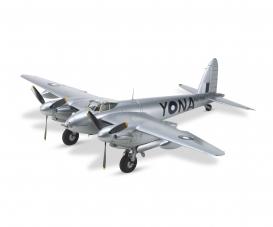
Model aircraft kits 1:32
1:32 DeHavilland Mosquito FB MK.VI
300160326available in stores
Article number: 300060326 Product: 1:32 DeHavilland Mosquito FB Mk.VI The "Wooden Wonder" makes an appearance in highly impressive 1/32 scale! That was the nickname given to the De Havilland Mosquito series of aircraft, an ingenious and beautiful design which saw the versatile airplane made almost entirely of wood. By the late 1930s, when design work on the Mosquito started, metal was the overwhelmingly favored medium. However, the Mosquito's designer foresaw that metal would become a precious resource in the probable war ahead; what was more, his highly lightweight wooden aircraft would be able to outrun heavier metal opponents. Constructed mainly from balsa wood sandwiched between sheets of birch, the Mosquito was originally designed as a weaponless bomber; once the armed forces and designers realized that the aircraft could withstand enemy fire even if it was caught, a number of variants were produced. The FB Mk.VI debuted in Spring 1943: this fighter-bomber variant packed four 7.7mm machine guns in the nose, plus four powerful 20mm autocannons and the ability to mount four 500lb bombs. Its outstanding speed and range ensured that the FB Mk.VI was used in a range of missions, including raids on important targets and infrastructure in the German homeland. It is often said that, until the advent of the Messerschmitt Me262, the German Luftwaffe did not have an adequate response to the "Mossie." Warning! Not suitable for children under 14 years.
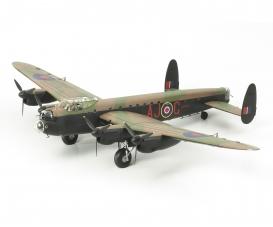
Model aircraft kits 1:48
1:48 Avro Dambuster Grand Slam
300061111available in stores
Article number: 300061111 Product: 1:48 Avro Dambuster Grand Slam This product is basically a diorama ready for assembly and painting: it includes two classic Tamiya 1/48 scale models (Items 61013 and 32558), plus a base and diorama sheet! With an easy-to-follow and logical model assembly process, the set is a great choice for modelling beginners or veterans alike who wish to create a realistic scene. • Item 61013 1/48 scale Nakajima Ki-84-Ia Hayate (Frank) assembly kit x1. This classic kit accurately recreates the Hayate form complete with fuselage surface detailing, a choice of open or closed canopy, deployed or retracted landing gear, 2 figures and 4 marking options. • Item 32558 1/48 scale Japanese 4x4 Light Vehicle Type 95 Kurogane assembly kit x1. This compact 75mm-length model kit captures the vehicle's unique style. The interior features 3 seats, while a choice of open- or closed-top parts are included. 2 figures are included. • Item 73021 Display Base (Large/Surface 300x160mm) x1. This is a perfect size for displaying your finished Hayate and Kurogane models. It is made from paintable styrene resin, and features sloped sides with a flat back face. • Item 66615 Diorama Material Sheet (Turf) x1. Add the final touch of realism with this sheet. A4 in size, it features yellow, green and brown fibers around 3mm in length that make for a strikingly authentic depiction of a grass surface. Warning! Not suitable for children under 14 years.
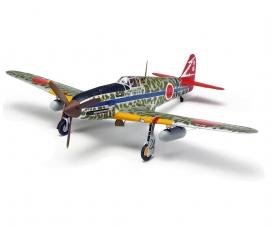
Model aircraft kits 1:48
1:48 Jap. Ki-61-I d Hien
300061115available in stores
Article number: 300061115 Product: 1:48 Jap. Ki-61-I d Hien The Kawasaki Ki-61 Hien was a WWII Japanese fighter powered by the Ha-40 engine - a license-produced version of a Daimler-Benz power plant. On account of its liquid cooled engine (it was the only Japanese fighter in the Pacific fighting to have one), the Hien was apparently mistaken for a German aircraft and then for an Italian bird, and was given the reporting nickname "Tony." It saw combat action from early 1943 and proved a competitive aircraft with its top speed of 580km/h, used in the desperate Japanese defense of the Solomon Islands and even as an interceptor when U.S. B-29s got in range to bomb the Japanese home islands toward the end of WWII. Warning! Not suitable for children under 14 years.
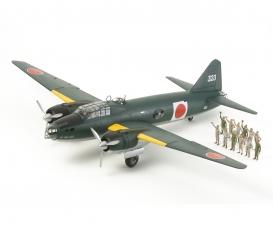
Model aircraft kits 1:48
1:48 Jap. Mitsubishi G4M1 Modell 11 (17)
300061110available in stores
Article number: 300061110 Product: 1/48 WWII Mitsubishi G4M1 Modell 11 (17) During WWII, the IJN's Combined Fleet had moved its headquarters to Truk. Admiral Isoroku Yamamoto, who commanded the Pearl Harbor Attack, arrived at Truk on April 3, 1943 and planned a visit to the forward bases at Balalae, Buin, and the Shortland Islands to boost the morale of the frontline units. However, the Americans had deciphered Japanese communications on April 13th which mentioned the details of the visit and the U.S. Army Air Force arranged an interception mission. At 6:05AM on April 18th, the two G4M1 bombers departed Rabaul for Balalae. The first aircraft, No.323, had eleven people on board, including Yamamoto. The second aircraft, No.326, had twelve people on board, including Vice Admiral Matome Ugaki. At 8:00AM, a group of P-38 Lightning fighters attacked the bombers and Yamamoto's aircraft turned left toward Buin while Ugaki's aircraft turned right toward the sea. Both aircraft were hit and Ugaki survived a crash-landing on the water, but Yamamoto's aircraft crashed into the jungle. A search party reached Yamamoto's aircraft on the evening of the 19th and his body was found outside the aircraft, still seated and with his sword in his hands. The Tamiya model faithfully captures the history of this last flight and the personnel on board. Warning! Not suitable for children under 14 years.
Perfect replicas of famous aircraft
Our model aeroplanes offer you detailed reproductions of historical aircraft. Whether you're a passionate collector or model builder, our display models are precisely crafted and perfect for expanding your collection or starting new projects.
Wide selection of display aircraft
We offer a large selection of model aeroplanes, known for their attention to detail and high-quality craftsmanship. Each display model is designed to capture the distinctive features of the original, from the finest lines to the characteristic details of the aeroplane's surface. These models are not only a highlight for model building enthusiasts but also a perfect collector's item for aviation fans. Particularly popular are our fighter plane models, which replicate famous military machines from various eras. Our range also includes light aeroplane models and historical motor planes.
Model aircraft for beginners and advanced builders
Whether you're just entering the world of model building or are an experienced builder – our model aeroplanes offer the right model for every skill level. Our models come as kits, allowing you to showcase your craftsmanship and assemble the model step by step. Each aeroplane project offers the opportunity to develop your model-building skills further and ultimately hold an impressive display model in your hands.
Discover the fascinating world of model aeroplanes
Immerse yourself in the world of model building and explore our wide range of model aeroplanes. From military fighter plane models to motor planes and light aircraft – you’ll find the perfect model to complete your collection or start a new project.

